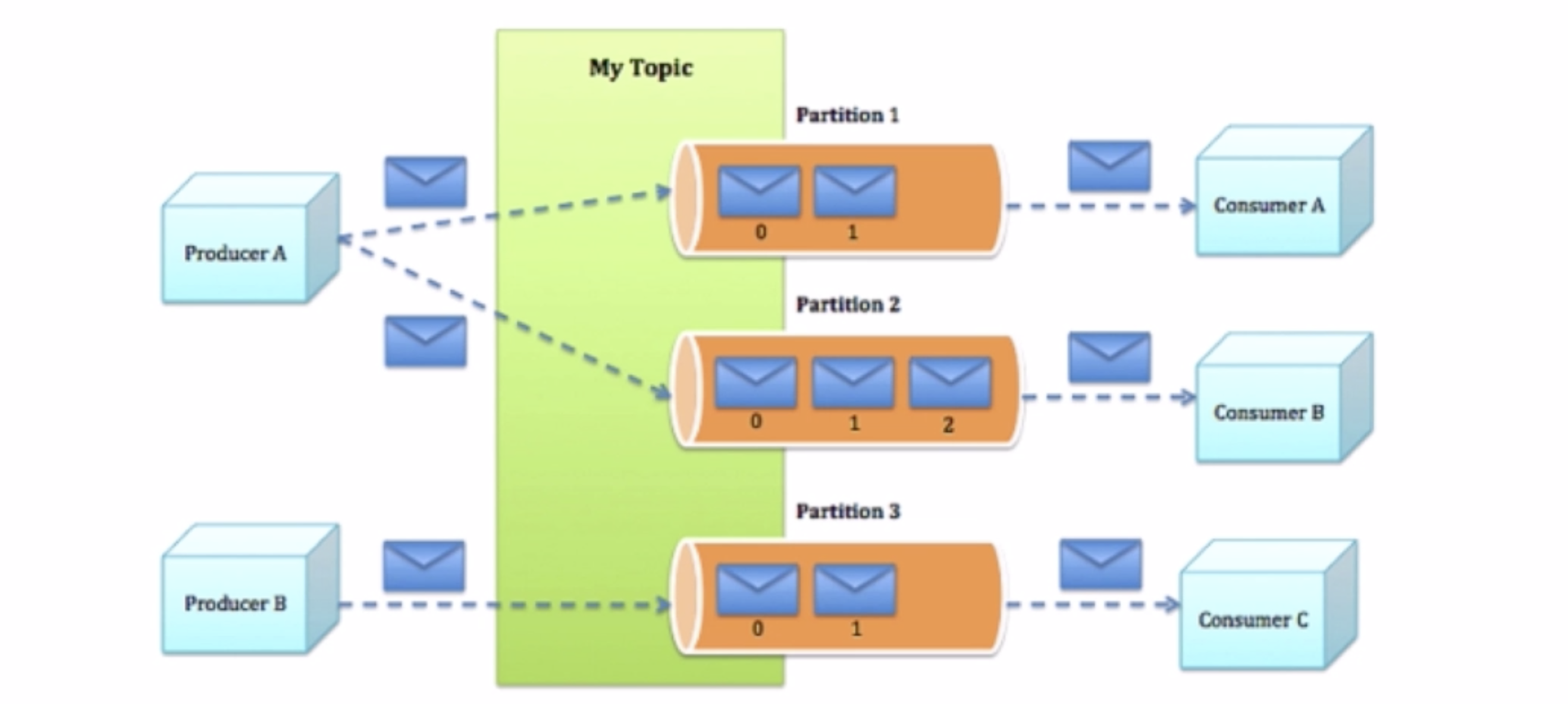并发及并发的线程安全处理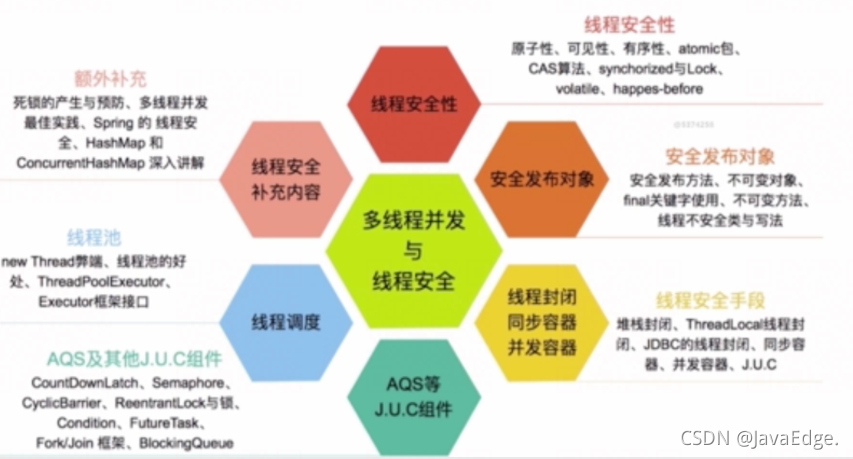
- 高并发处理的思路及手段
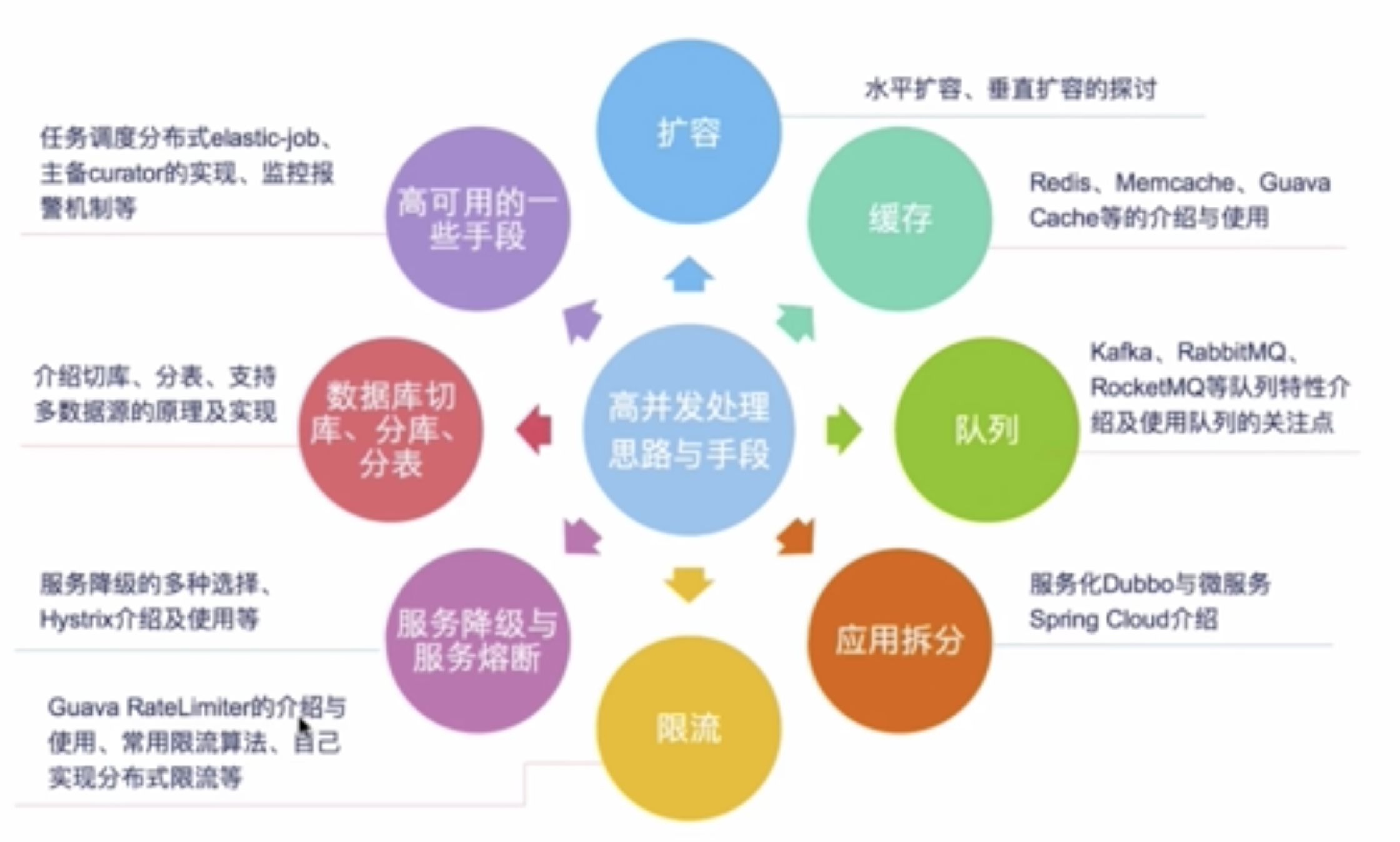
1 基本概念
1.1 并发
同时拥有两个或者多个线程,如果程序在单核处理器上运行多个线程将交替地换入或者换出内存,这些线程是同时“存在"的,每个线程都处于执行过程中的某个状态,如果运行在多核处理器上,此时,程序中的每个线程都将分配到一个处理器核上,因此可以同时运行.
##1.2 高并发( High Concurrency)
互联网分布式系统架构设计中必须考虑的因素之一,通常是指,通过设计保证系统能够同时并行处理很多请求.
##1.3 区别与联系
- 并发: 多个线程操作相同的资源,保证线程安全,合理使用资源
- 高并发:服务能同时处理很多请求,提高程序性能
2 CPU
2.1 CPU 多级缓存

- 为什么需要CPU cache
CPU的频率太快了,快到主存跟不上
如此,在处理器时钟周期内,CPU常常需要等待主存,浪费资源。所以cache的出现,是为了缓解CPU和内存之间速度的不匹配问题(结构:cpu-> cache-> memory ). - CPU cache的意义
- 时间局部性
如果某个数据被访问,那么在不久的将来它很可能被再次访问 - 空间局部性
如果某个数据被访问,那么与它相邻的数据很快也可能被访问
- 时间局部性
2.2 缓存一致性(MESI)
用于保证多个 CPU cache 之间缓存共享数据的一致
- M-modified被修改
该缓存行只被缓存在该 CPU 的缓存中,并且是被修改过的,与主存中数据是不一致的,需在未来某个时间点写回主存,该时间是允许在其他CPU 读取主存中相应的内存之前,当这里的值被写入主存之后,该缓存行状态变为 E - E-exclusive独享
缓存行只被缓存在该 CPU 的缓存中,未被修改过,与主存中数据一致
可在任何时刻当被其他 CPU读取该内存时变成 S 态,被修改时变为 M态 - S-shared共享
该缓存行可被多个 CPU 缓存,与主存中数据一致 - I-invalid无效
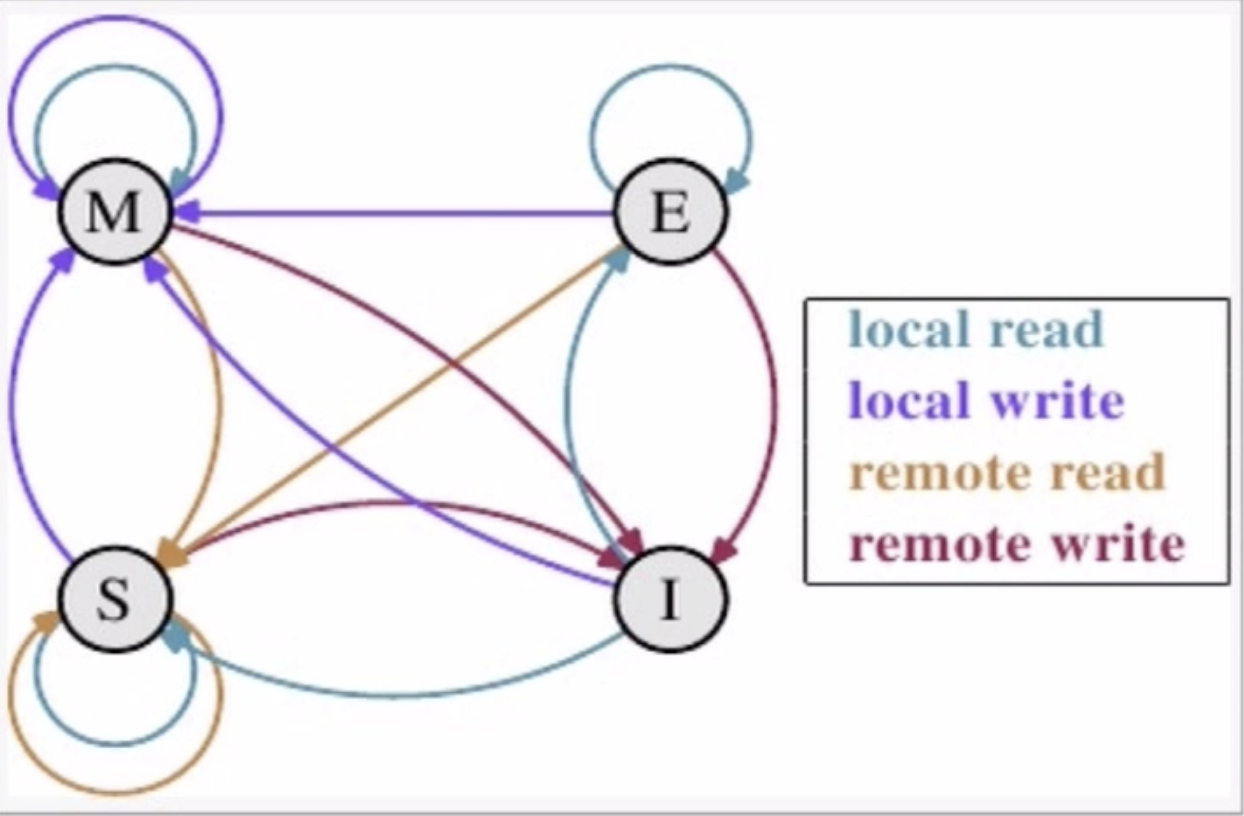
- 乱序执行优化
处理器为提高运算速度而做出违背代码原有顺序的优化
并发的优势与风险
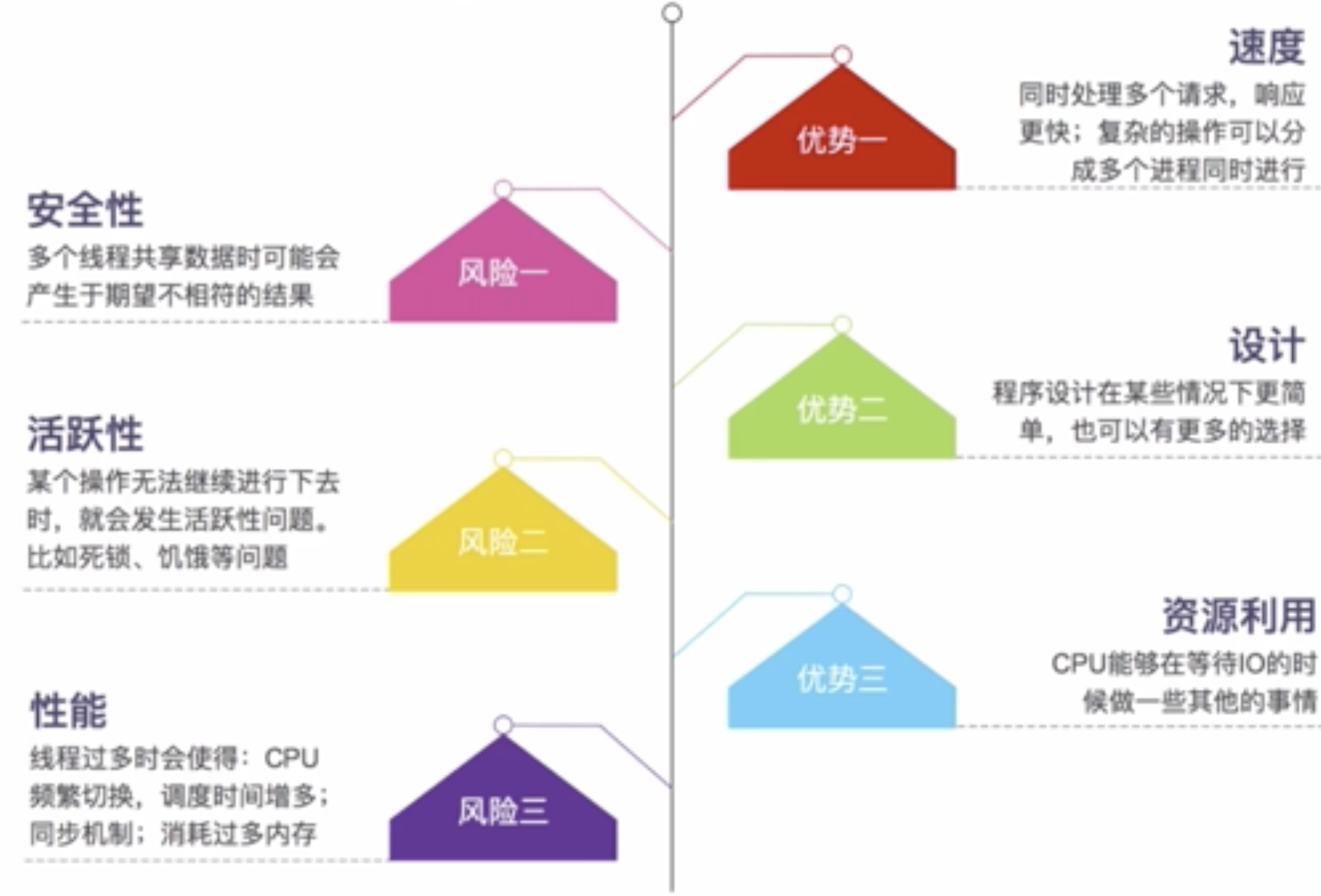
3 项目准备
3.1 项目初始化
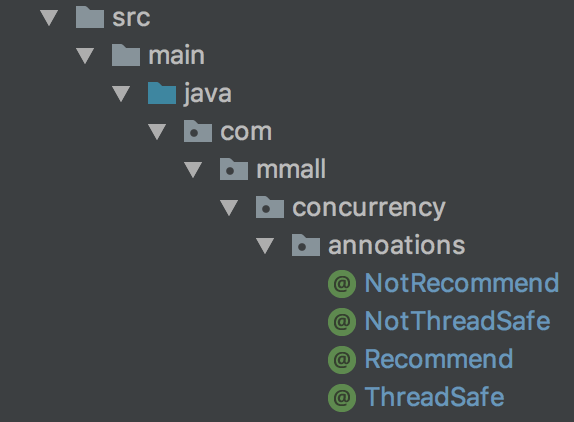
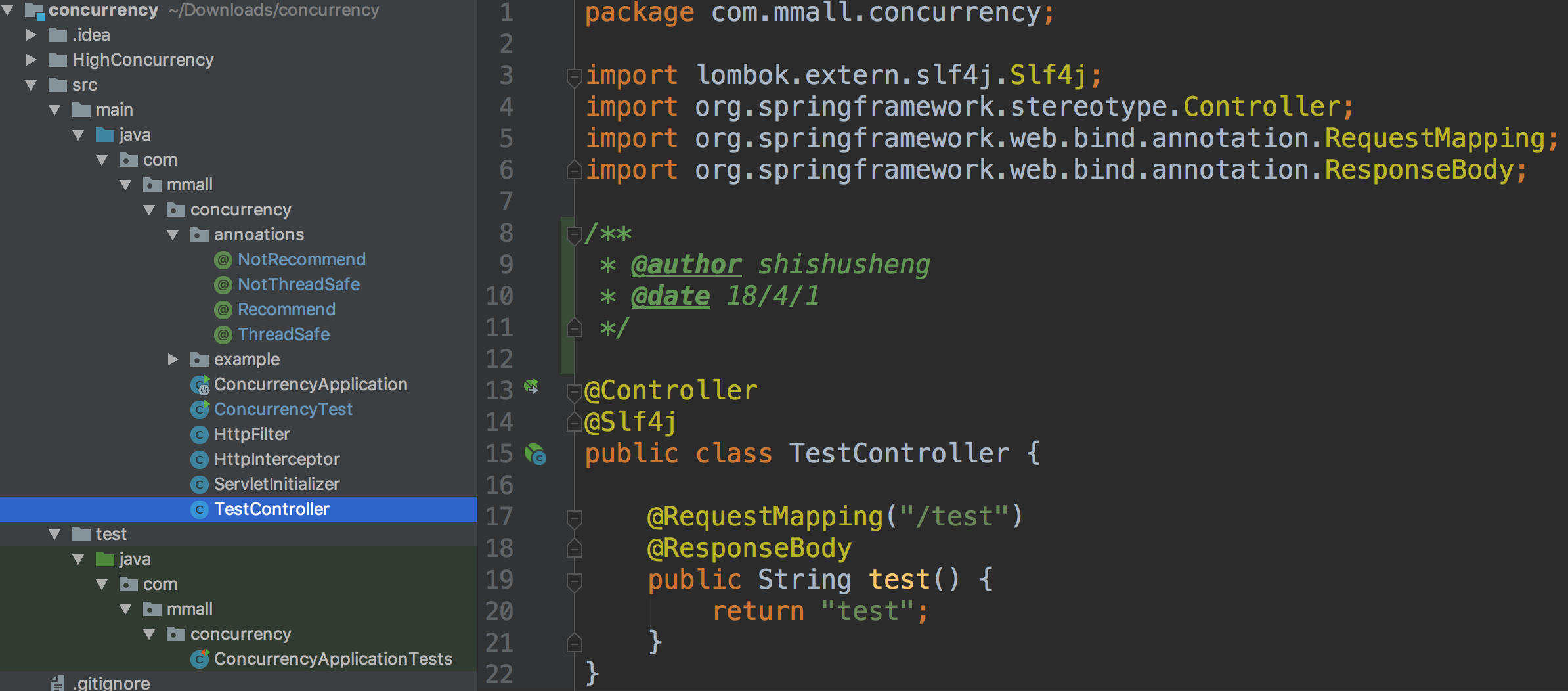

3.2 并发模拟-Jmeter压测
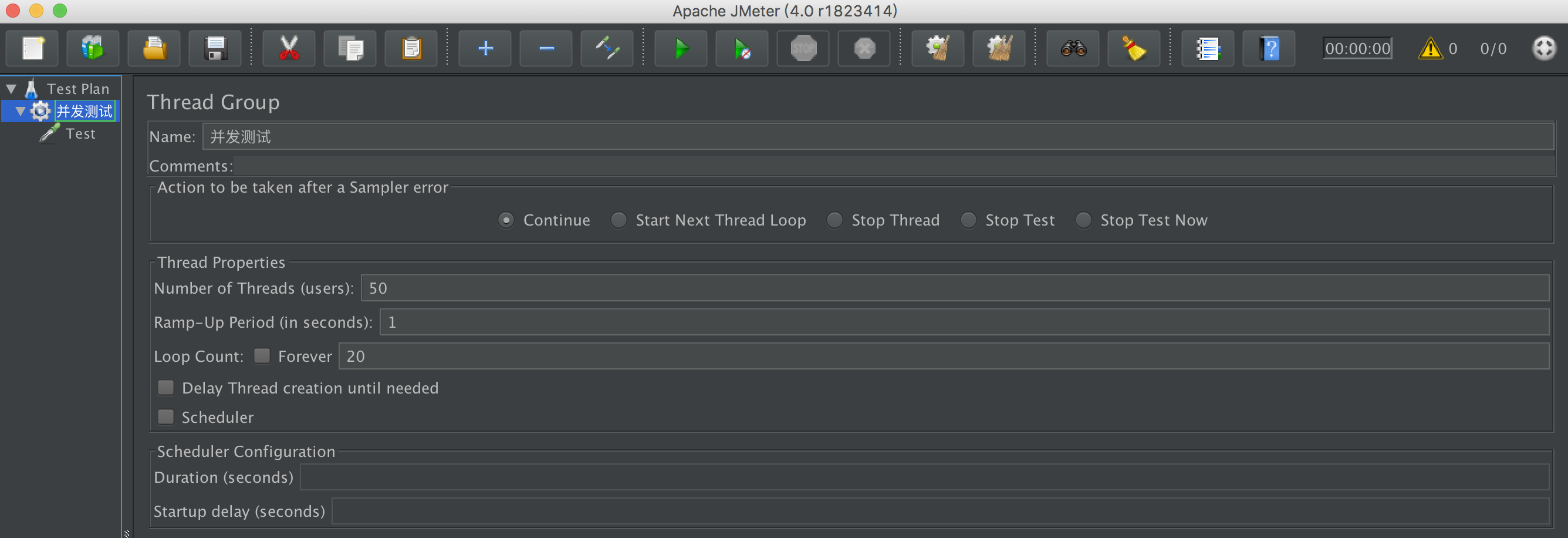

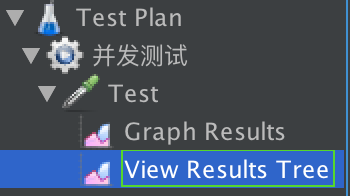
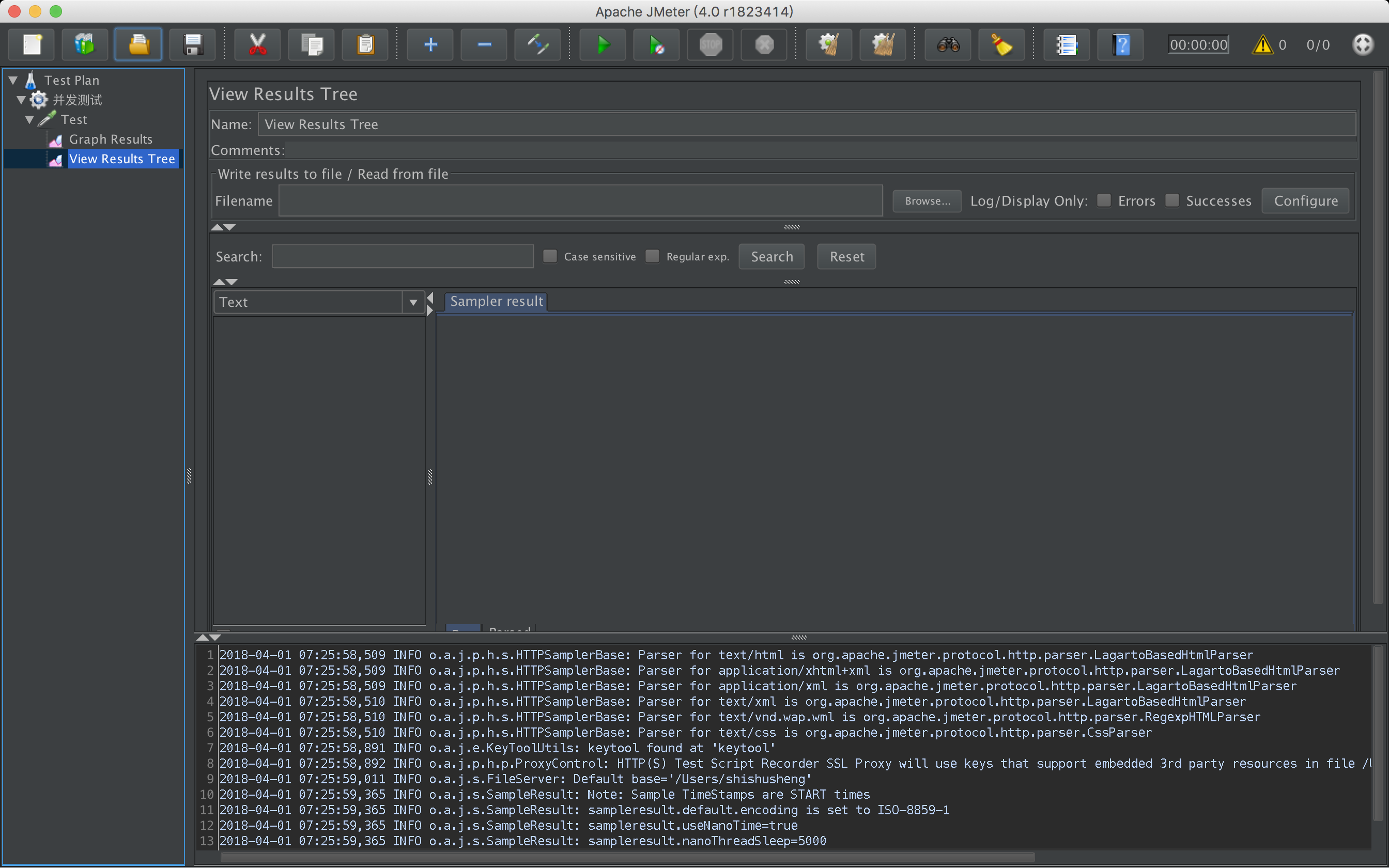

3.3 并发模拟-代码
CountDownLatch
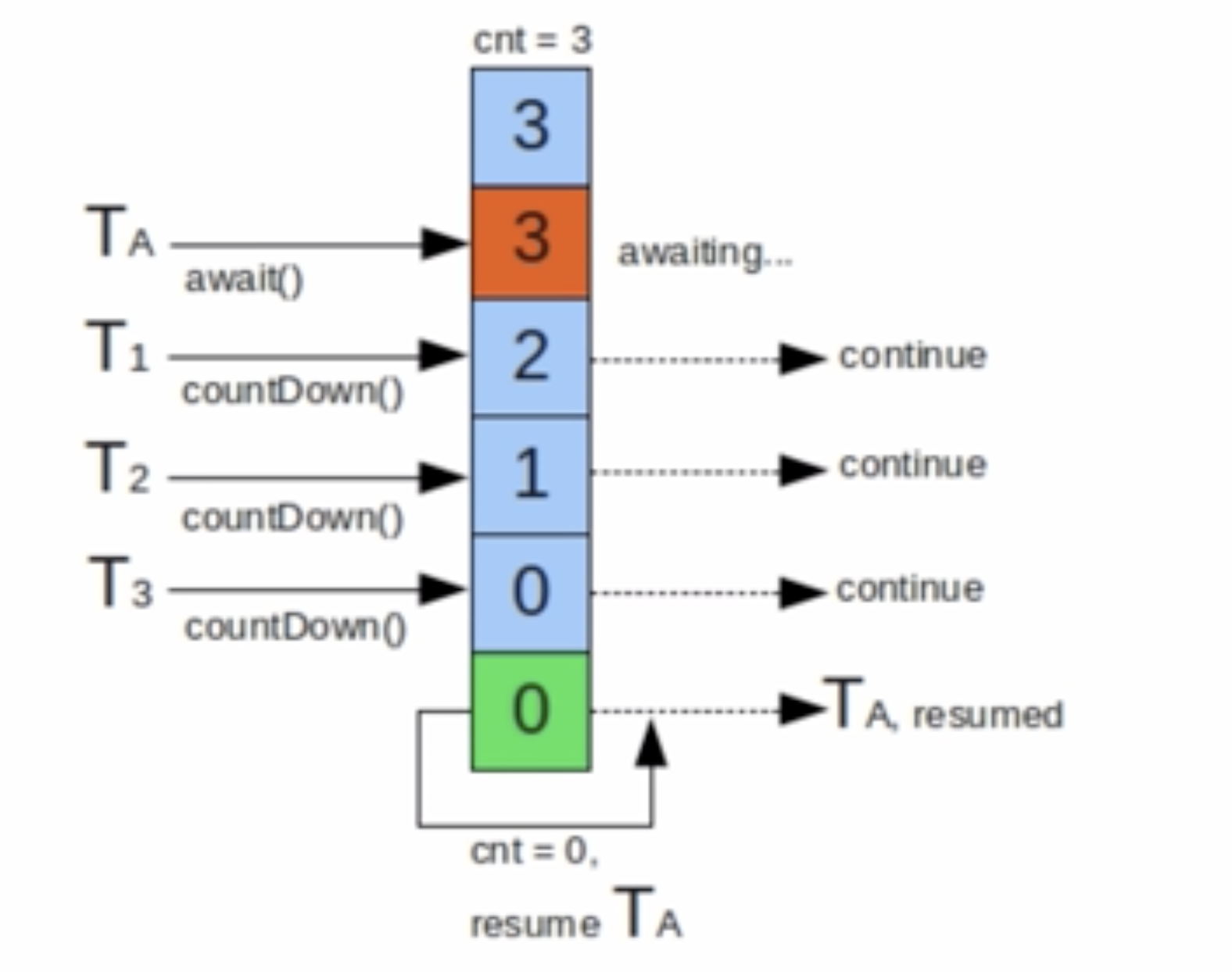
###Semaphore(信号量)

以上二者通常和线程池搭配
下面开始做并发模拟
package com.mmall.concurrency;
import com.mmall.concurrency.annoations.NotThreadSafe;
import lombok.extern.slf4j.Slf4j;
import java.util.concurrent.CountDownLatch;
import java.util.concurrent.ExecutorService;
import java.util.concurrent.Executors;
import java.util.concurrent.Semaphore;
/**
* @author JavaEdge
* @date 18/4/1
*/
@Slf4j
@NotThreadSafe
public class ConcurrencyTest {
/**
* 请求总数
*/
public static int clientTotal = 5000;
/**
* 同时并发执行的线程数
*/
public static int threadTotal = 200;
public static int count = 0;
public static void main(String[] args) throws Exception {
//定义线程池
ExecutorService executorService = Executors.newCachedThreadPool();
//定义信号量,给出允许并发的线程数目
final Semaphore semaphore = new Semaphore(threadTotal);
//统计计数结果
final CountDownLatch countDownLatch = new CountDownLatch(clientTotal);
//将请求放入线程池
for (int i = 0; i < clientTotal ; i++) {
executorService.execute(() -> {
try {
//信号量的获取
semaphore.acquire();
add();
//释放
semaphore.release();
} catch (Exception e) {
log.error("exception", e);
}
countDownLatch.countDown();
});
}
countDownLatch.await();
//关闭线程池
executorService.shutdown();
log.info("count:{}", count);
}
/**
* 统计方法
*/
private static void add() {
count++;
}
}
运行发现结果随机,所以非线程安全
4 线程安全性
4.1 线程安全性
当多个线程访问某个类时,不管运行时环境采用何种调度方式或者这些进程将如何交替执行,并且在主调代码中不需要任何额外的同步或协同,这个类都能表现出正确的行为,那么就称这个类是线程安全的
4.2 原子性
并非一气呵成,岂能无懈可击
4.2.1 Atomic 包
- AtomicXXX:CAS,Unsafe.compareAndSwapInt
提供了互斥访问,同一时刻只能有一个线程来对它进行操作
package com.mmall.concurrency.example.atomic;
import com.mmall.concurrency.annoations.ThreadSafe;
import lombok.extern.slf4j.Slf4j;
import java.util.concurrent.CountDownLatch;
import java.util.concurrent.ExecutorService;
import java.util.concurrent.Executors;
import java.util.concurrent.Semaphore;
import java.util.concurrent.atomic.AtomicLong;
/**
* @author JavaEdge
*/
@Slf4j
@ThreadSafe
public class AtomicExample2 {
/**
* 请求总数
*/
public static int clientTotal = 5000;
/**
* 同时并发执行的线程数
*/
public static int threadTotal = 200;
/**
* 工作内存
*/
public static AtomicLong count = new AtomicLong(0);
public static void main(String[] args) throws Exception {
ExecutorService executorService = Executors.newCachedThreadPool();
final Semaphore semaphore = new Semaphore(threadTotal);
final CountDownLatch countDownLatch = new CountDownLatch(clientTotal);
for (int i = 0; i < clientTotal ; i++) {
executorService.execute(() -> {
try {
System.out.println();
semaphore.acquire();
add();
semaphore.release();
} catch (Exception e) {
log.error("exception", e);
}
countDownLatch.countDown();
});
}
countDownLatch.await();
executorService.shutdown();
//主内存
log.info("count:{}", count.get());
}
private static void add() {
count.incrementAndGet();
// count.getAndIncrement();
}
}
@Slf4j
@ThreadSafe
public class AtomicExample4 {
private static AtomicReference<Integer> count = new AtomicReference<>(0);
public static void main(String[] args) {
// 2
count.compareAndSet(0, 2);
// no
count.compareAndSet(0, 1);
// no
count.compareAndSet(1, 3);
// 4
count.compareAndSet(2, 4);
// no
count.compareAndSet(3, 5);
log.info("count:{}", count.get());
}
}

-
AtomicReference,AtomicReferenceFieldUpdater
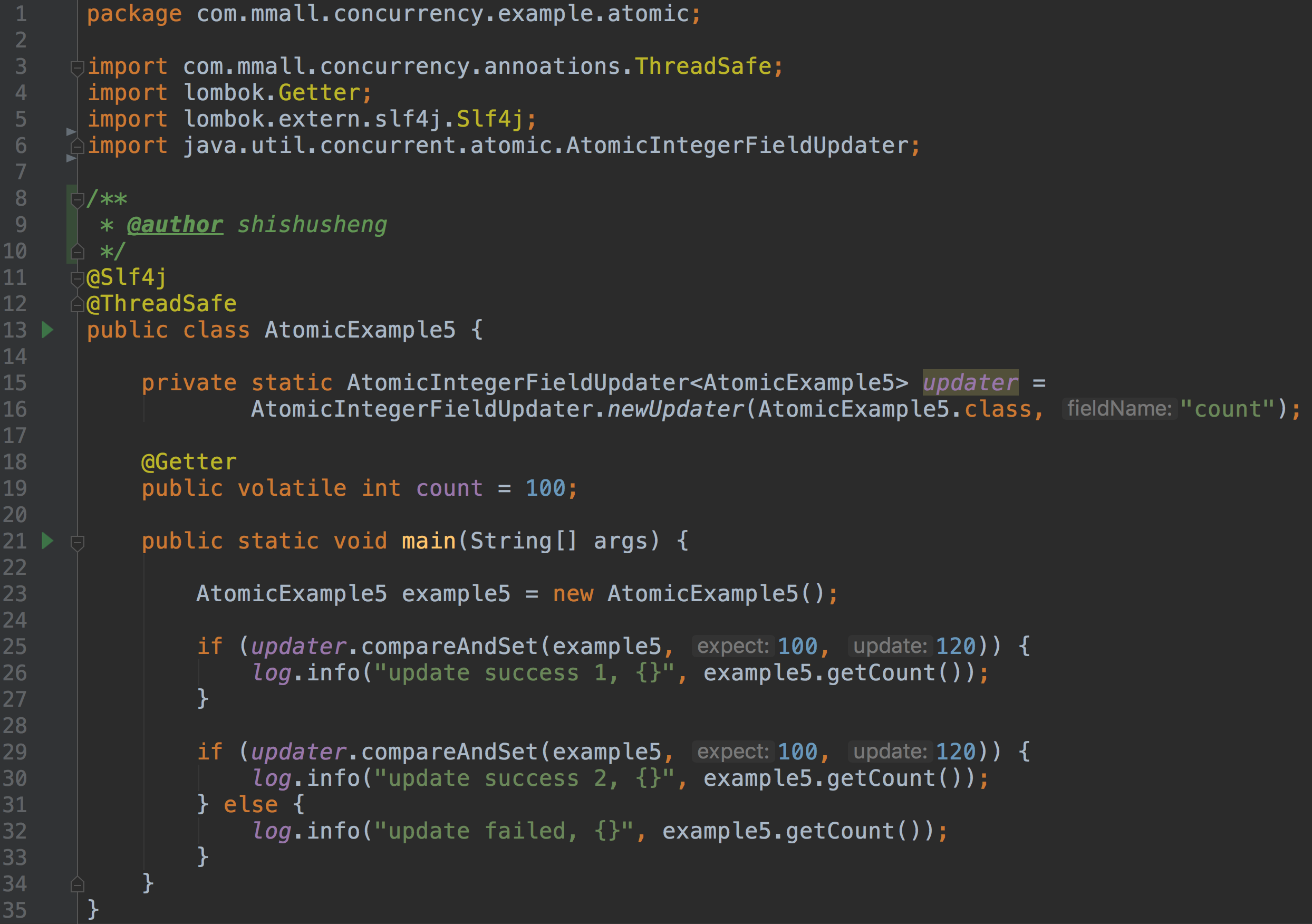
-
AtomicBoolean

-
AtomicStampReference : CAS的 ABA 问题
4.2.2 锁
synchronized:依赖 JVM
- 修饰代码块:大括号括起来的代码,作用于调用的对象
- 修饰方法: 整个方法,作用于调用的对象
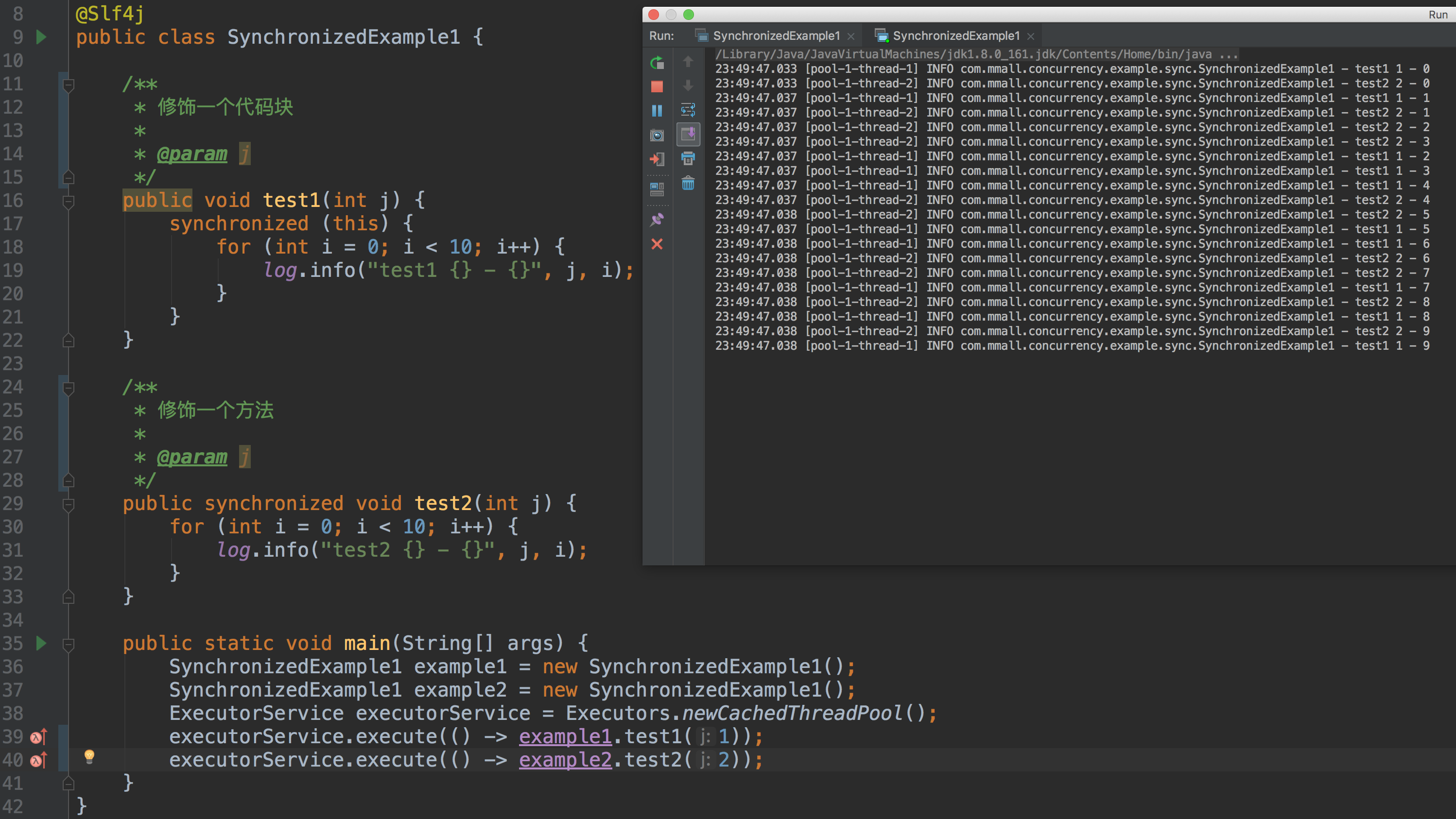
- 修饰静态方法:整个静态方法,作用于所有对象
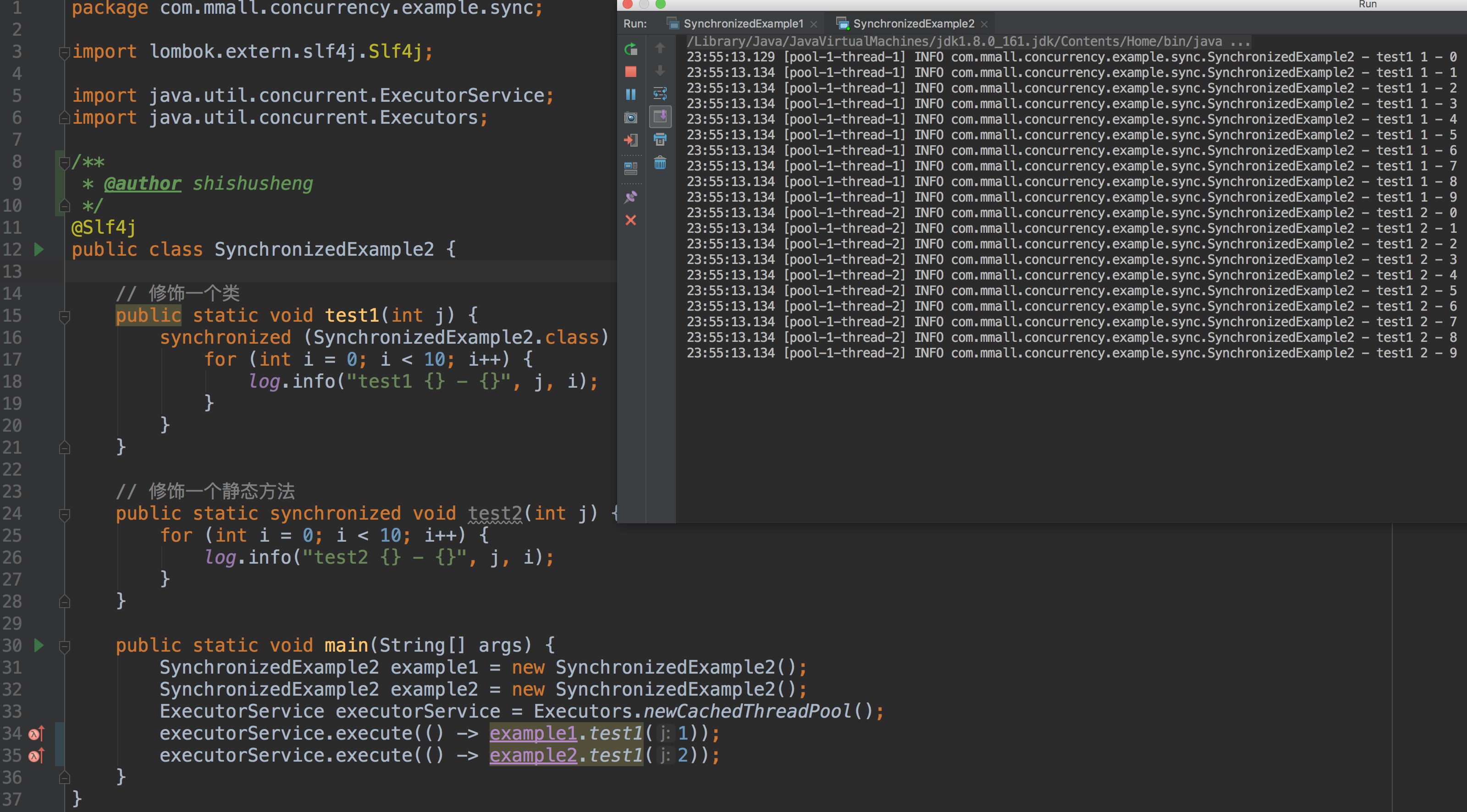
package com.mmall.concurrency.example.count;
import com.mmall.concurrency.annoations.ThreadSafe;
import lombok.extern.slf4j.Slf4j;
import java.util.concurrent.CountDownLatch;
import java.util.concurrent.ExecutorService;
import java.util.concurrent.Executors;
import java.util.concurrent.Semaphore;
/**
* @author JavaEdge
*/
@Slf4j
@ThreadSafe
public class CountExample3 {
/**
* 请求总数
*/
public static int clientTotal = 5000;
/**
* 同时并发执行的线程数
*/
public static int threadTotal = 200;
public static int count = 0;
public static void main(String[] args) throws Exception {
ExecutorService executorService = Executors.newCachedThreadPool();
final Semaphore semaphore = new Semaphore(threadTotal);
final CountDownLatch countDownLatch = new CountDownLatch(clientTotal);
for (int i = 0; i < clientTotal ; i++) {
executorService.execute(() -> {
try {
semaphore.acquire();
add();
semaphore.release();
} catch (Exception e) {
log.error("exception", e);
}
countDownLatch.countDown();
});
}
countDownLatch.await();
executorService.shutdown();
log.info("count:{}", count);
}
private synchronized static void add() {
count++;
}
}
synchronized 修正计数类方法
- 修饰类:括号括起来的部分,作用于所有对象
子类继承父类的被 synchronized 修饰方法时,是没有 synchronized 修饰的!!!
Lock: 依赖特殊的 CPU 指令,代码实现
4.2.3 对比
- synchronized: 不可中断锁,适合竞争不激烈,可读性好
- Lock: 可中断锁,多样化同步,竞争激烈时能维持常态
- Atomic: 竞争激烈时能维持常态,比Lock性能好; 只能同步一
个值
4.3 可见性
你做的改变,别人看不见。
一个线程对主内存的修改可以及时的被其他线程观察到
4.3.1 导致共享变量在线程间不可见的原因
- 线程交叉执行
- 重排序结合线程交叉执行
- 共享变量更新后的值没有在工作内存与主存间及时更新
4.3.2 可见性之synchronized
JMM关于synchronized的规定
- 线程解锁前,必须把共享变量的最新值刷新到主内存
- 线程加锁时,将清空工作内存中共享变量的值,从而使
用共享变量时需要从主内存中重新读取最新的值(加锁与解锁是同一把锁)
4.3.3 可见性之volatile
通过加入内存屏障和禁止重排序优化来实现
- 对volatile变量写操作时,会在写操作后加入一条store
屏障指令,将本地内存中的共享变量值刷新到主内存 - 对volatile变量读操作时,会在读操作前加入一条load
屏障指令,从主内存中读取共享变量
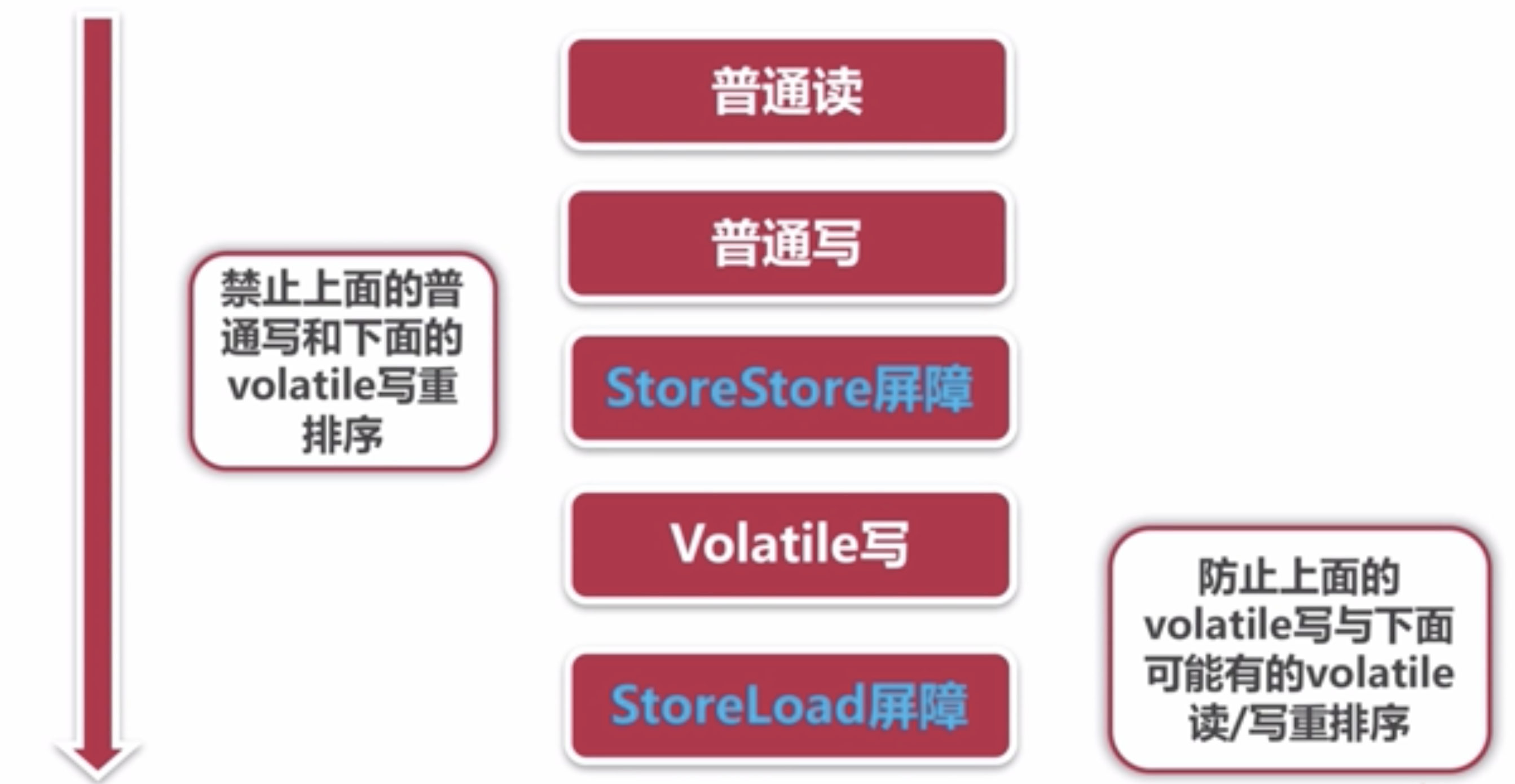

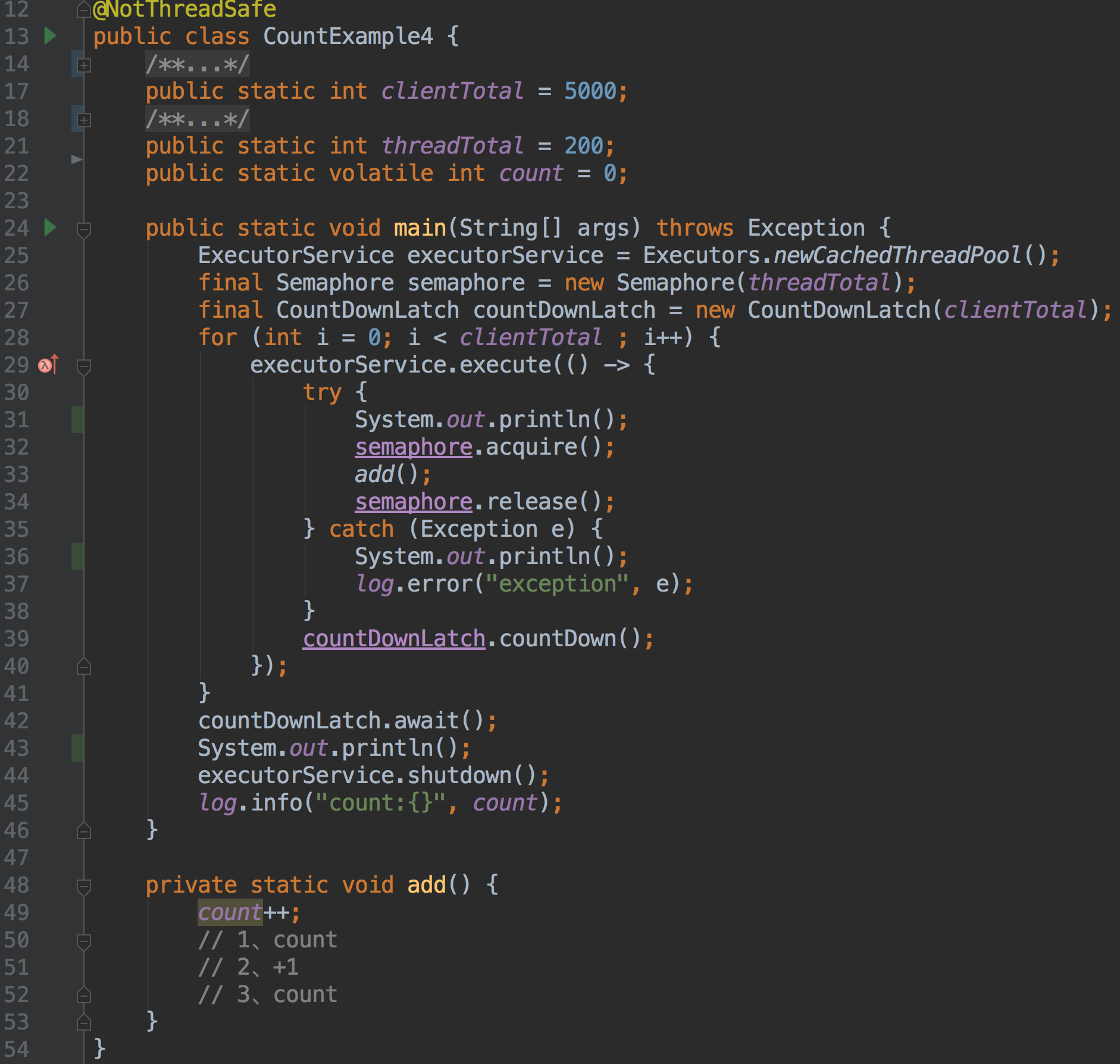
- volatile使用
volatile boolean inited = false;
//线程1:
context = loadContext();
inited= true;
// 线程2:
while( !inited ){
sleep();
}
doSomethingWithConfig(context)
4.4 有序性
不按套路出牌。
一个线程观察其他线程中的指令执行顺序,由于指令重排序的存在,该观察结果一般杂乱无序
JMM允许编译器和处理器对指令进行重排序,但是重排序过程不会影响到单线程程序的执行,却会影响到多线程并发执行的正确性
4.4.1 happens-before 规则
5发布对象
-
发布对象
使一个对象能够被当前范围之外的代码所使用 -
对象逸出
一种错误的发布。当-个对象还没有构造完成时,就使它被其他线程所见
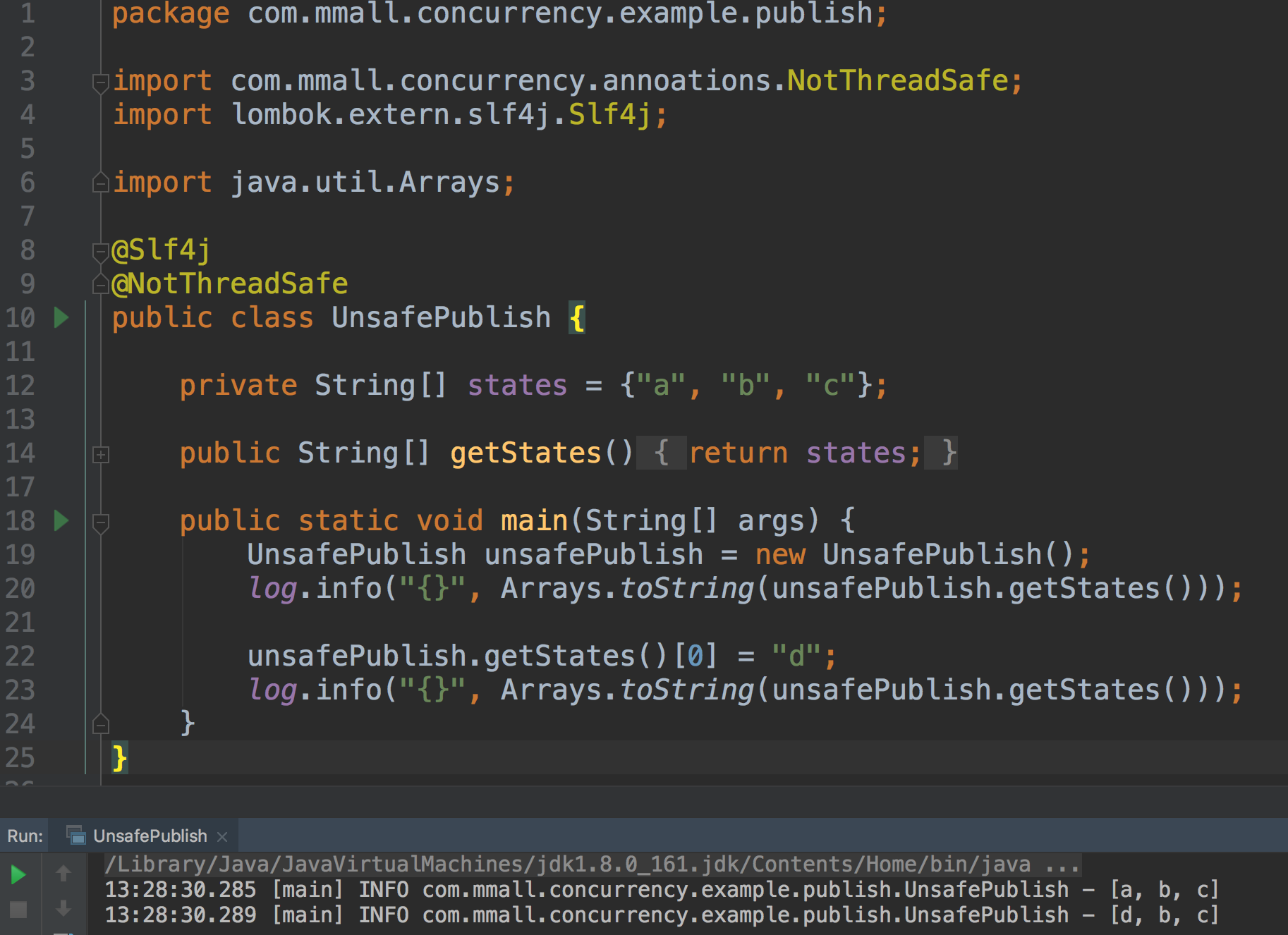
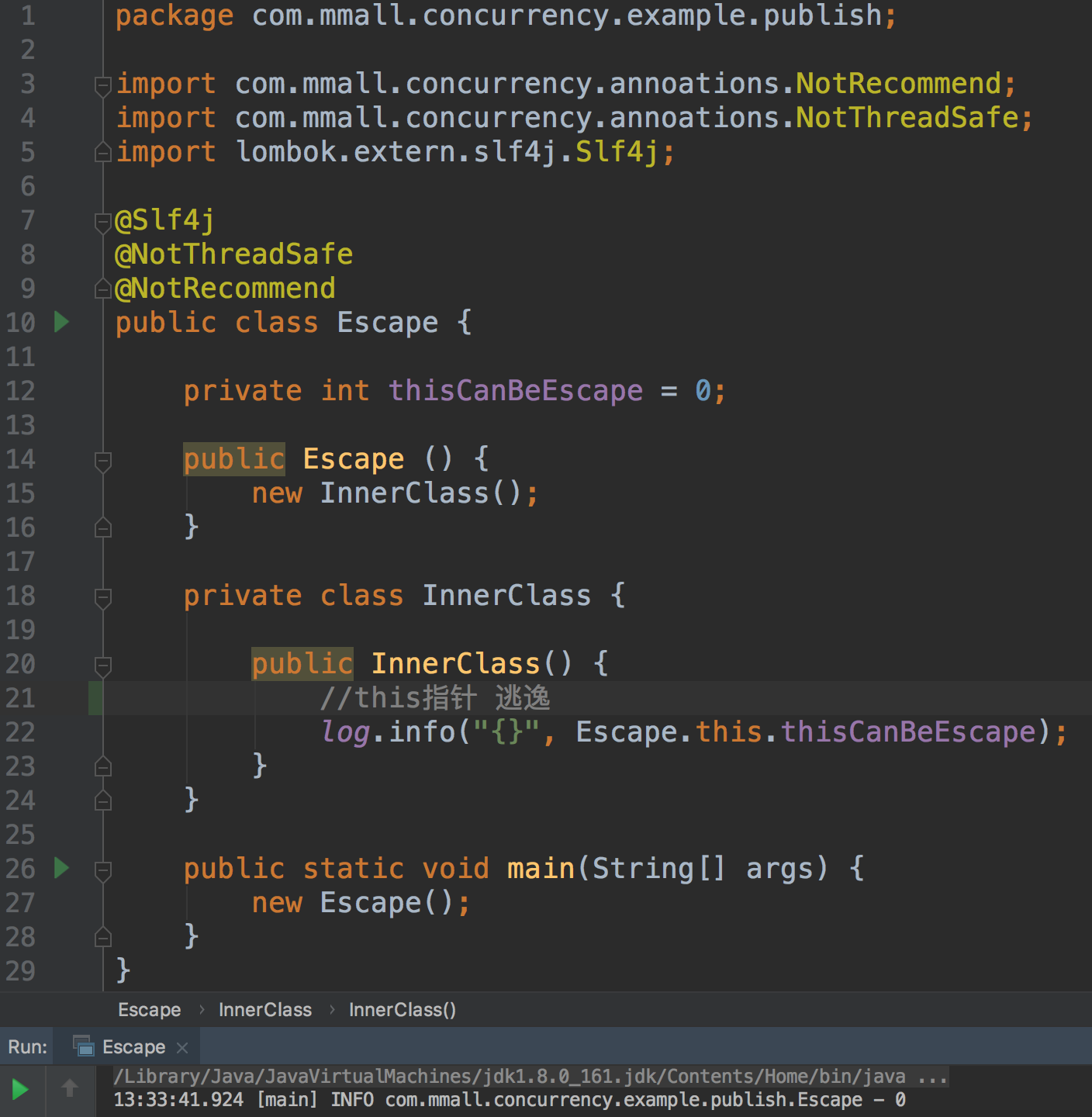
5.1 安全发布对象
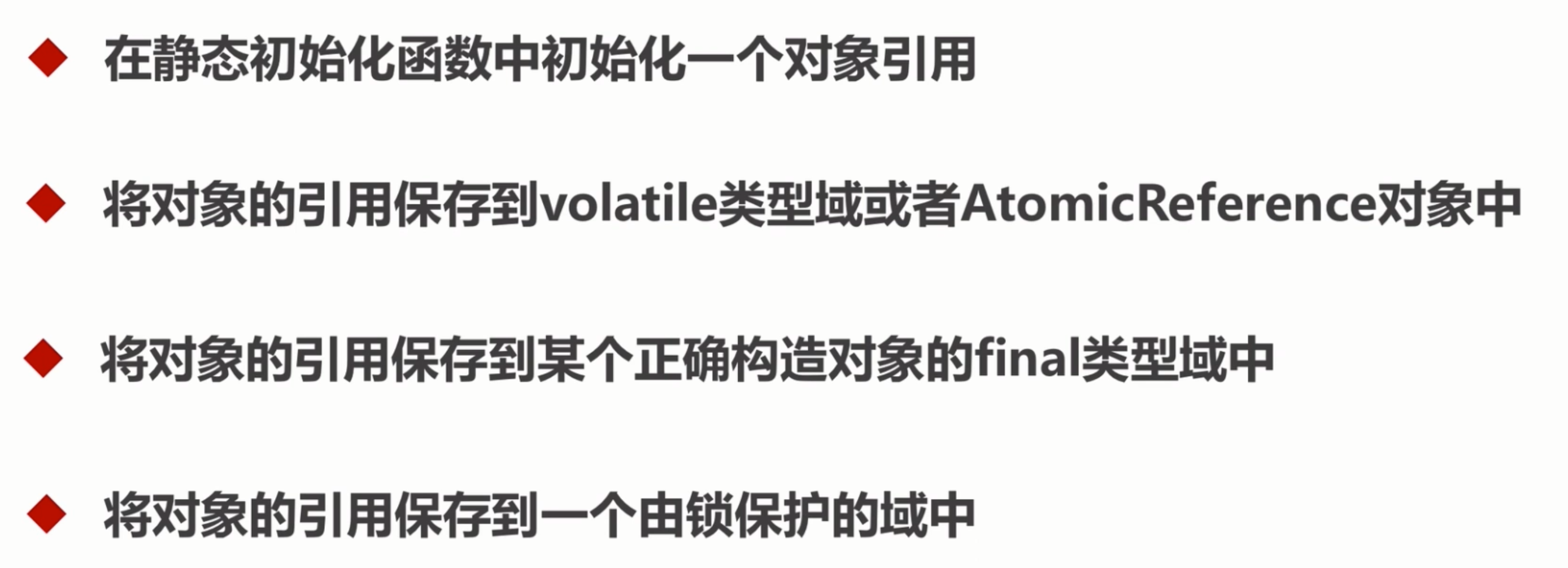
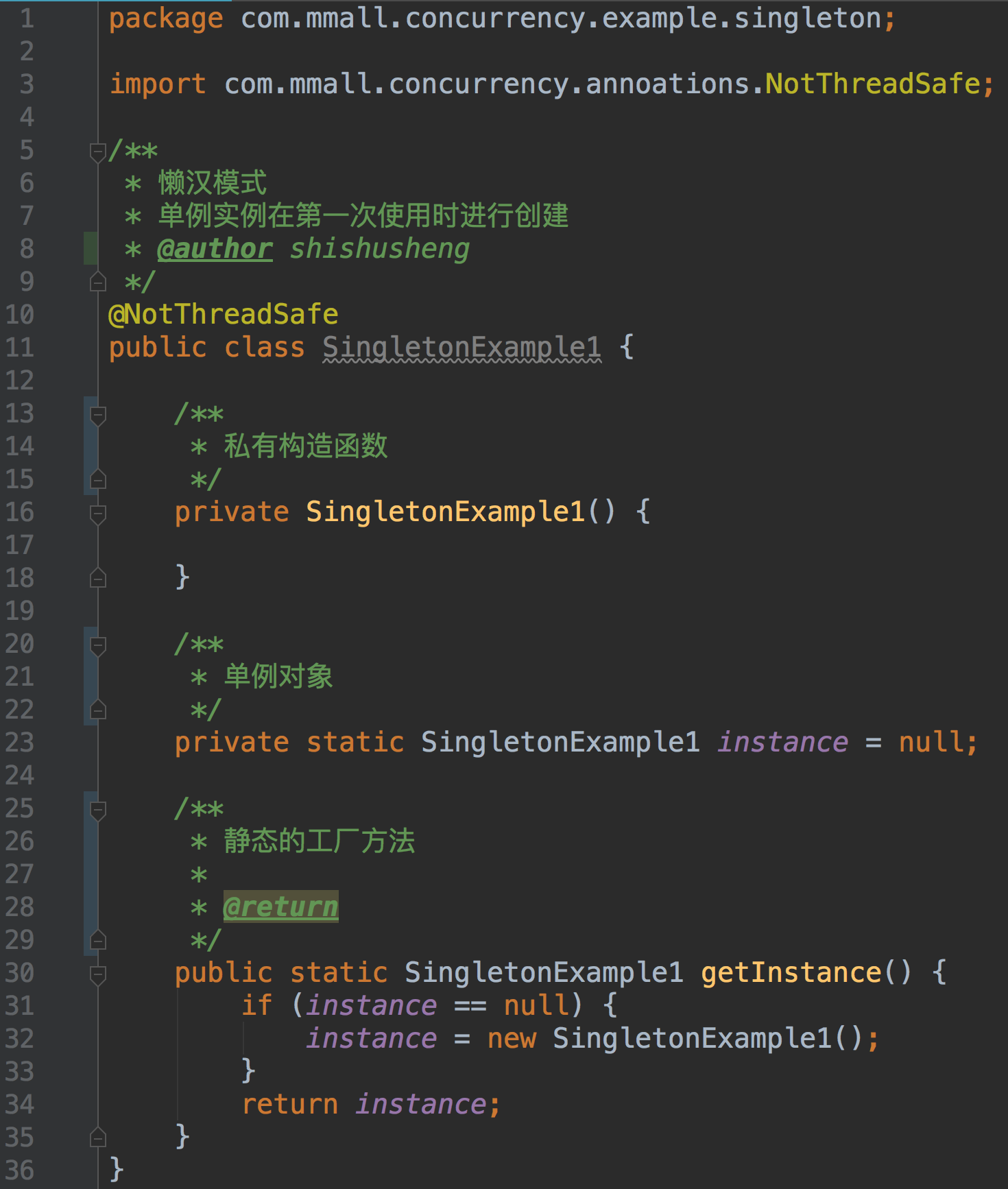

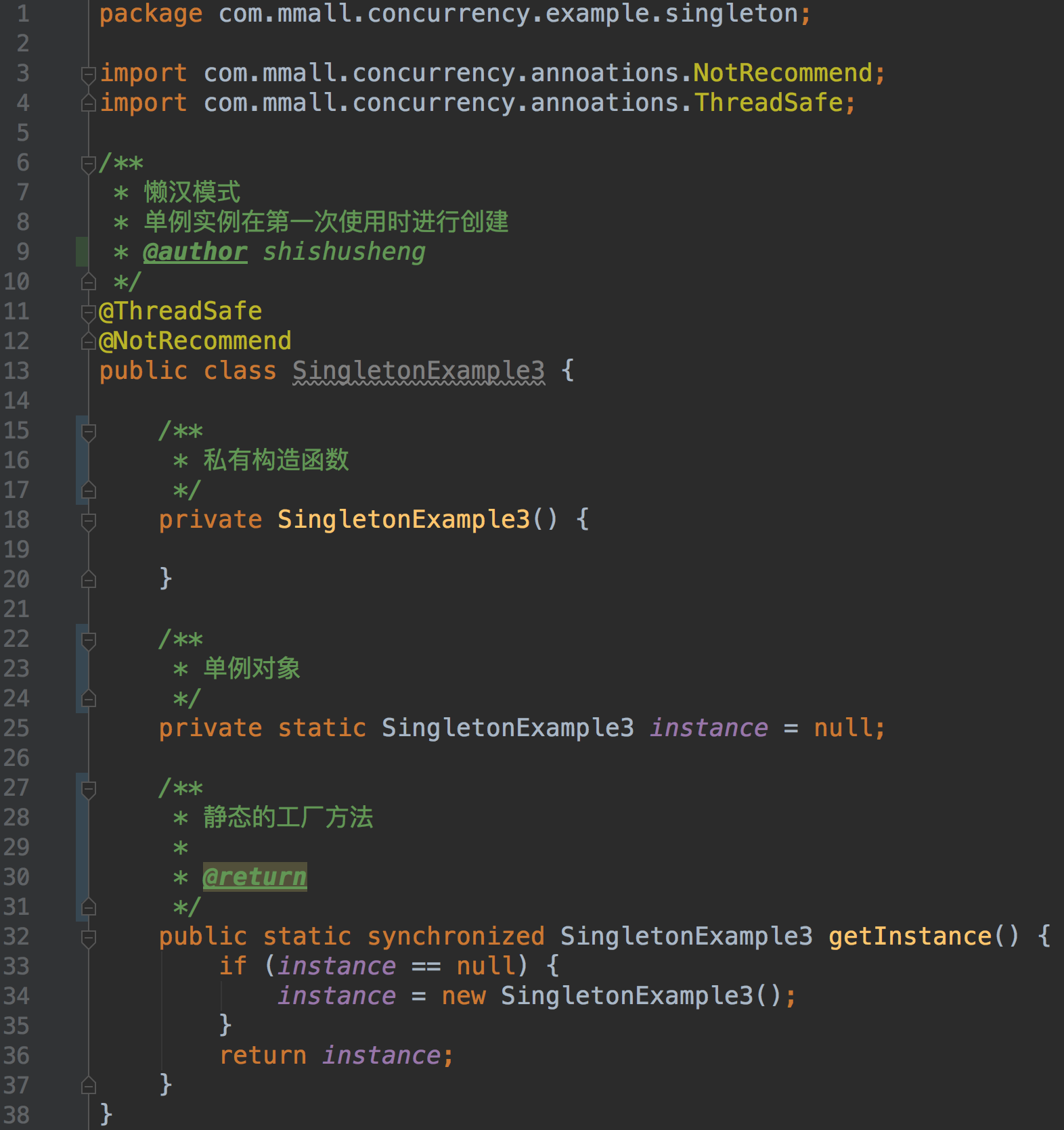
package com.mmall.concurrency.example.singleton;
import com.mmall.concurrency.annoations.NotThreadSafe;
/**
* 懒汉模式 -》 双重同步锁单例模式
* 单例实例在第一次使用时进行创建
* @author JavaEdge
*/
@NotThreadSafe
public class SingletonExample4 {
/**
* 私有构造函数
*/
private SingletonExample4() {
}
// 1、memory = allocate() 分配对象的内存空间
// 2、ctorInstance() 初始化对象
// 3、instance = memory 设置instance指向刚分配的内存
// JVM和cpu优化,发生了指令重排
// 1、memory = allocate() 分配对象的内存空间
// 3、instance = memory 设置instance指向刚分配的内存
// 2、ctorInstance() 初始化对象
/**
* 单例对象
*/
private static SingletonExample4 instance = null;
/**
* 静态的工厂方法
*
* @return
*/
public static SingletonExample4 getInstance() {
// 双重检测机制 // B
if (instance == null) {
// 同步锁
synchronized (SingletonExample4.class) {
if (instance == null) {
// A - 3
instance = new SingletonExample4();
}
}
}
return instance;
}
}
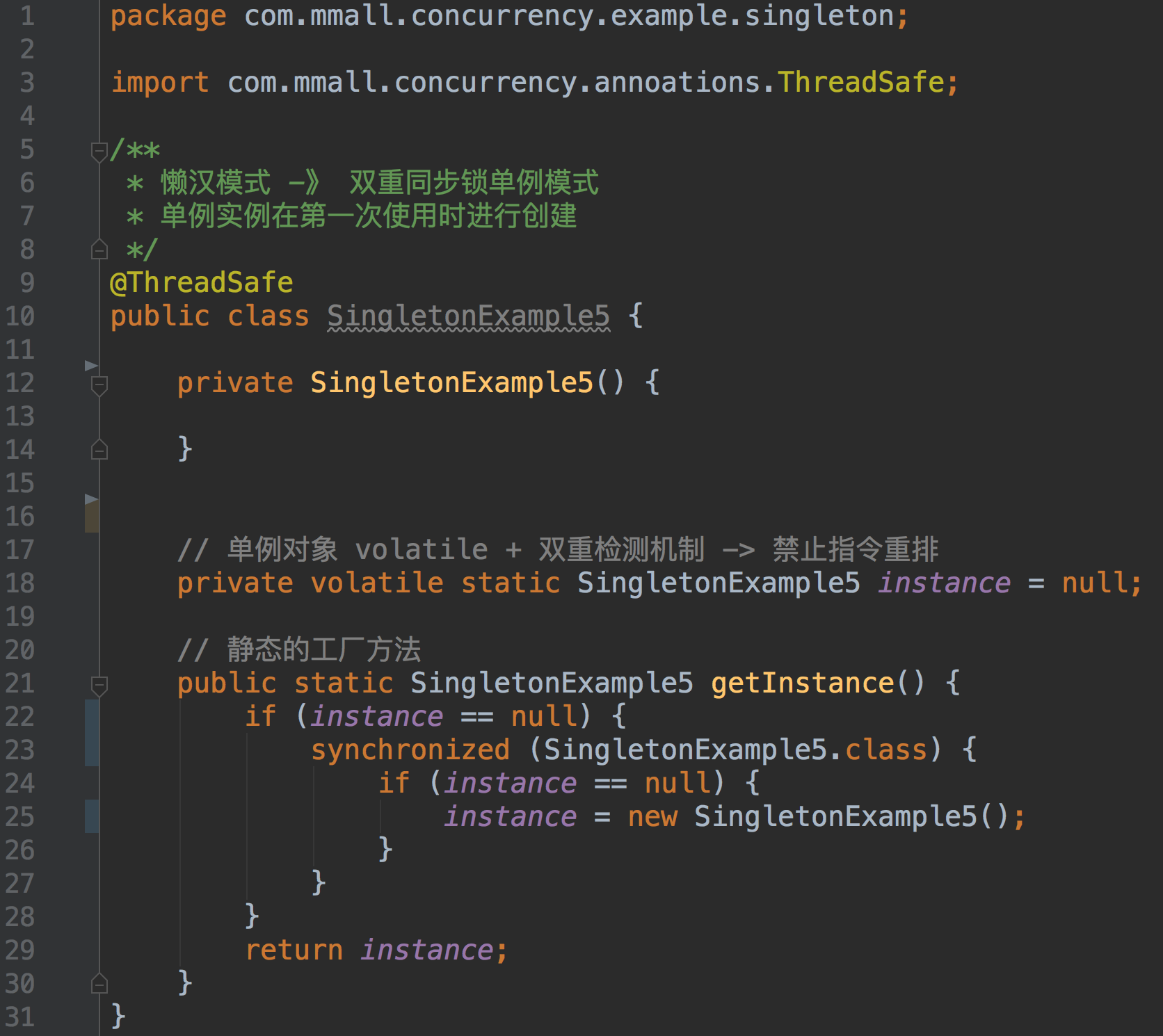
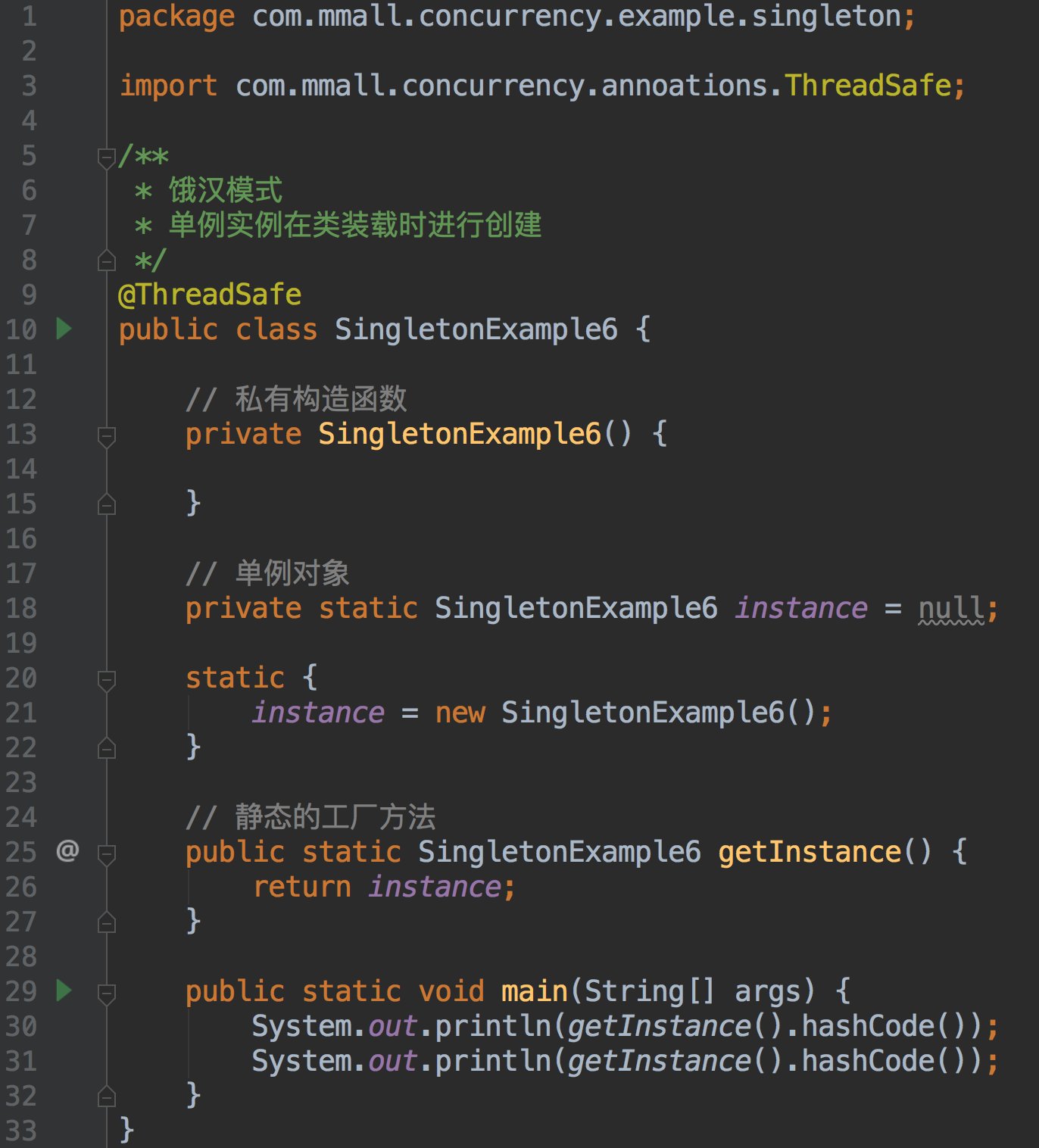
7 AQS
7.1 介绍

- 使用Node实现FIFO队列,可以用于构建锁或者其他同步装置的基础框架
- 利用了一个int类型表示状态
- 使用方法是继承
- 子类通过继承并通过实现它的方法管理其状态{acquire 和release} 的方法操纵状态
- 可以同时实现排它锁和共享锁模式(独占、共享)
同步组件
CountDownLatch
package com.mmall.concurrency.example.aqs;
import lombok.extern.slf4j.Slf4j;
import java.util.concurrent.CountDownLatch;
import java.util.concurrent.ExecutorService;
import java.util.concurrent.Executors;
/**
* @author JavaEdge
*/
@Slf4j
public class CountDownLatchExample1 {
private final static int threadCount = 200;
public static void main(String[] args) throws Exception {
ExecutorService exec = Executors.newCachedThreadPool();
final CountDownLatch countDownLatch = new CountDownLatch(threadCount);
for (int i = 0; i < threadCount; i++) {
final int threadNum = i;
exec.execute(() -> {
try {
test(threadNum);
} catch (Exception e) {
log.error("exception", e);
} finally {
countDownLatch.countDown();
}
});
}
countDownLatch.await();
log.info("finish");
exec.shutdown();
}
private static void test(int threadNum) throws Exception {
Thread.sleep(100);
log.info("{}", threadNum);
Thread.sleep(100);
}
}
package com.mmall.concurrency.example.aqs;
import lombok.extern.slf4j.Slf4j;
import java.util.concurrent.CountDownLatch;
import java.util.concurrent.ExecutorService;
import java.util.concurrent.Executors;
import java.util.concurrent.TimeUnit;
/**
* 指定时间内处理任务
*
* @author JavaEdge
*
*/
@Slf4j
public class CountDownLatchExample2 {
private final static int threadCount = 200;
public static void main(String[] args) throws Exception {
ExecutorService exec = Executors.newCachedThreadPool();
final CountDownLatch countDownLatch = new CountDownLatch(threadCount);
for (int i = 0; i < threadCount; i++) {
final int threadNum = i;
exec.execute(() -> {
try {
test(threadNum);
} catch (Exception e) {
log.error("exception", e);
} finally {
countDownLatch.countDown();
}
});
}
countDownLatch.await(10, TimeUnit.MILLISECONDS);
log.info("finish");
exec.shutdown();
}
private static void test(int threadNum) throws Exception {
Thread.sleep(100);
log.info("{}", threadNum);
}
}
##Semaphore用法
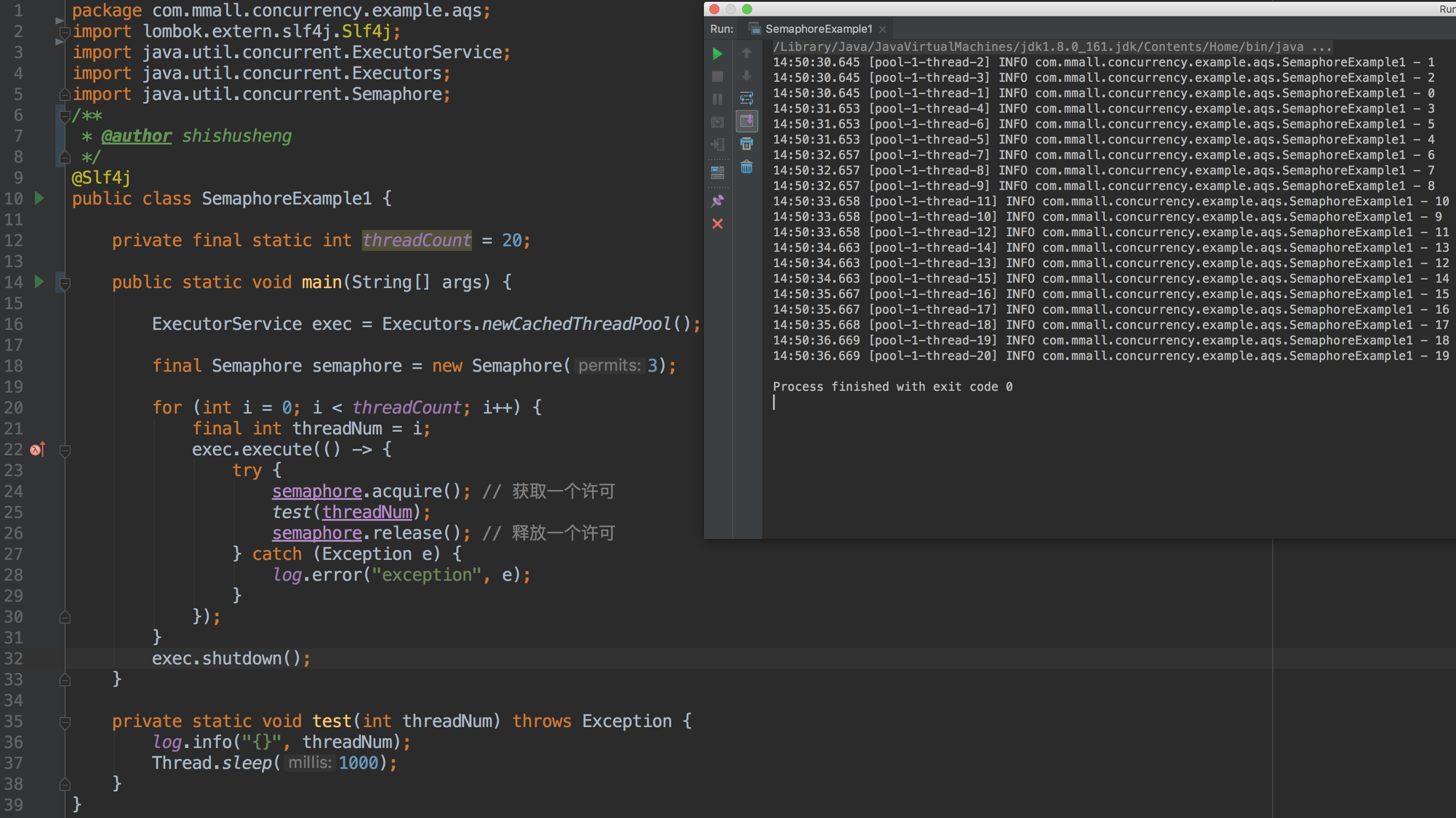
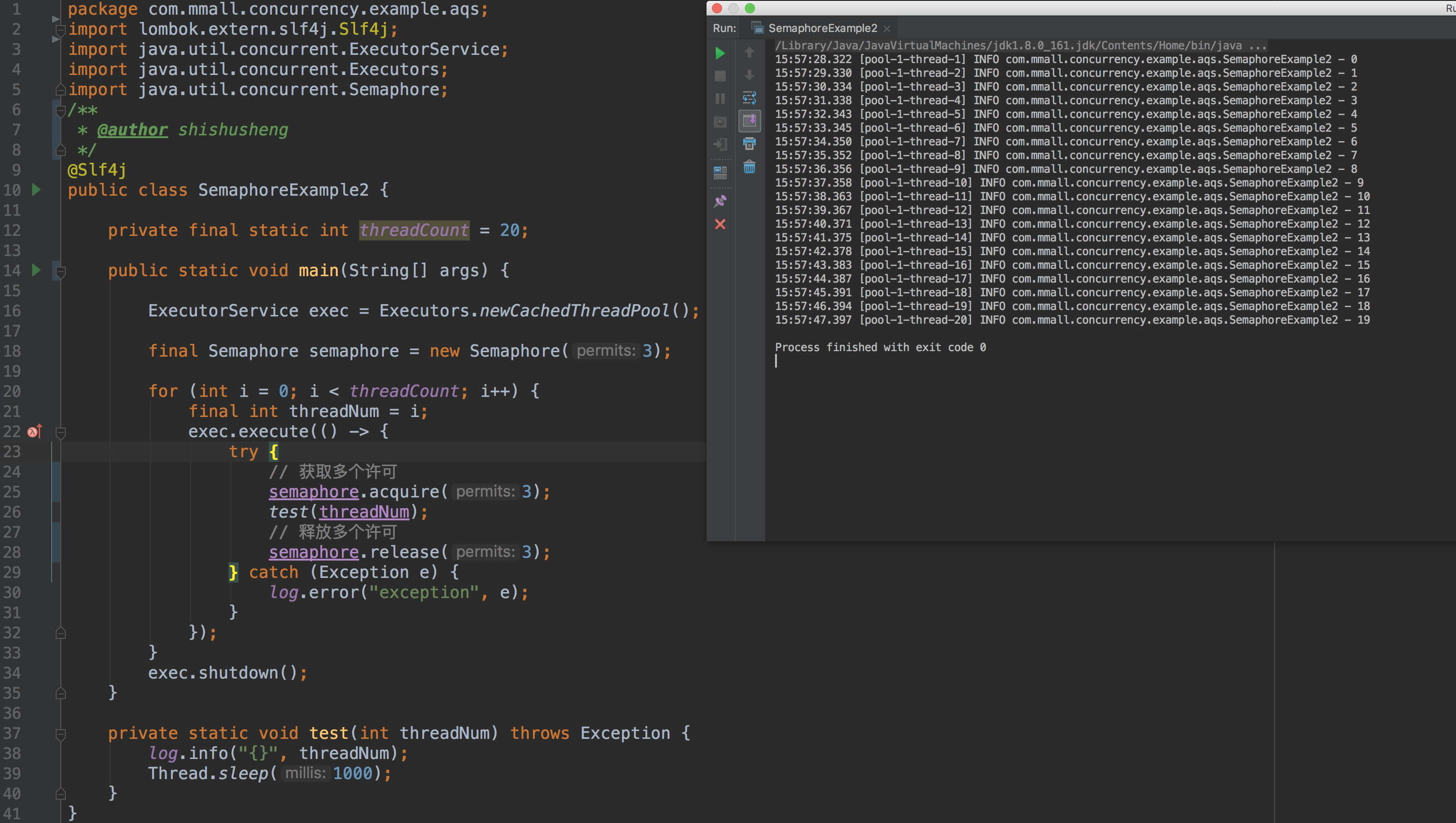
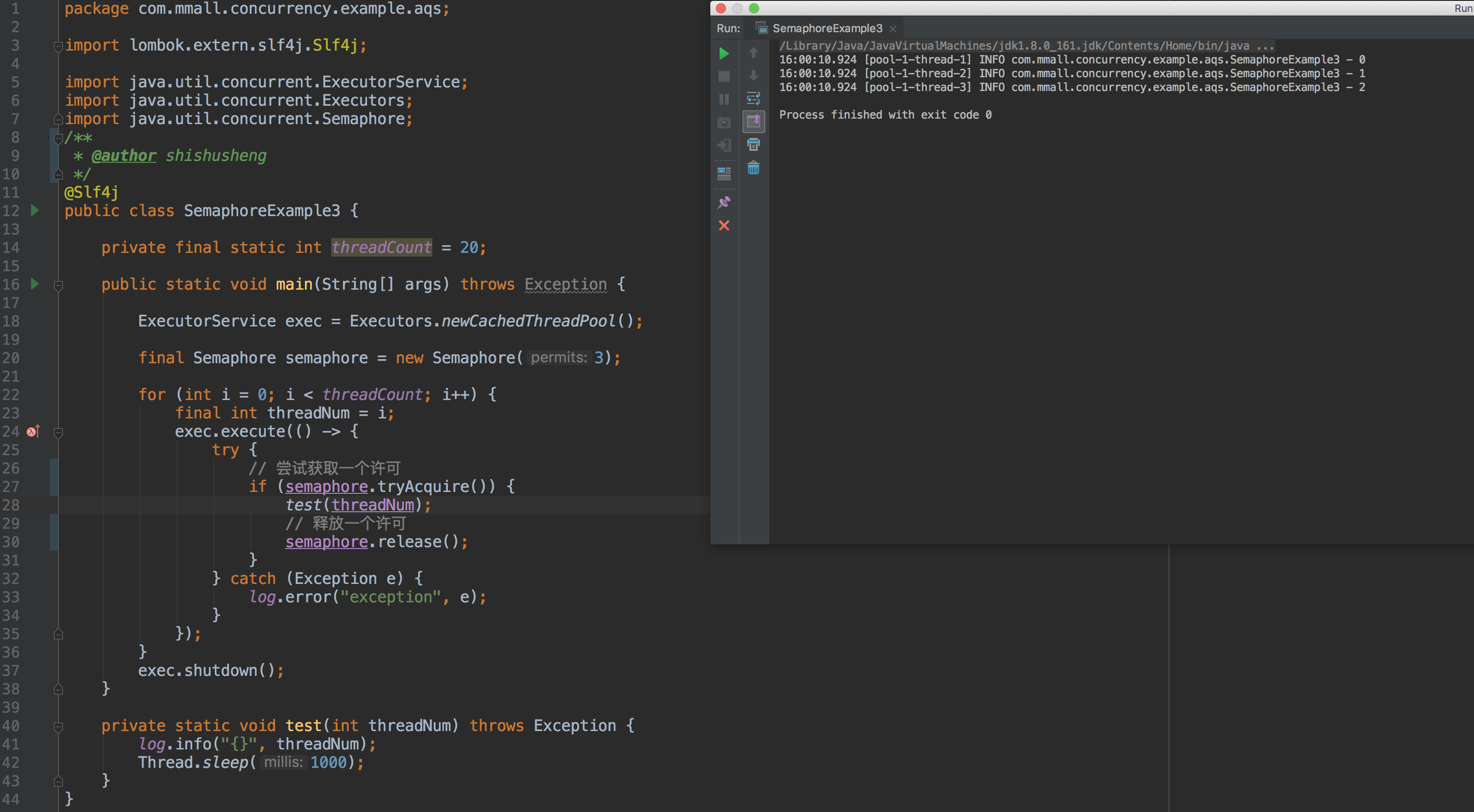
##CycliBarrier
package com.mmall.concurrency.example.aqs;
import lombok.extern.slf4j.Slf4j;
import java.util.concurrent.CyclicBarrier;
import java.util.concurrent.ExecutorService;
import java.util.concurrent.Executors;
/**
* @author JavaEdge
*/
@Slf4j
public class CyclicBarrierExample1 {
private static CyclicBarrier barrier = new CyclicBarrier(5);
public static void main(String[] args) throws Exception {
ExecutorService executor = Executors.newCachedThreadPool();
for (int i = 0; i < 10; i++) {
final int threadNum = i;
Thread.sleep(1000);
executor.execute(() -> {
try {
race(threadNum);
} catch (Exception e) {
log.error("exception", e);
}
});
}
executor.shutdown();
}
private static void race(int threadNum) throws Exception {
Thread.sleep(1000);
log.info("{} is ready", threadNum);
barrier.await();
log.info("{} continue", threadNum);
}
}
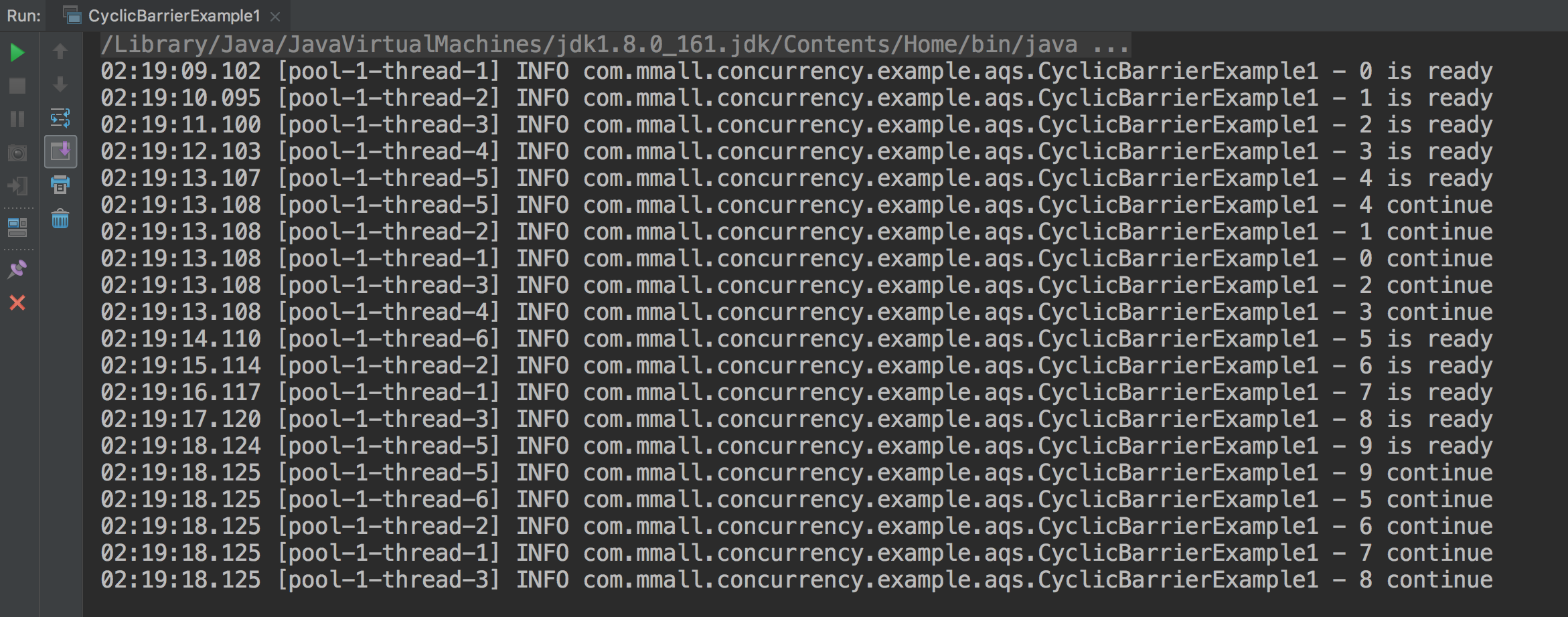
package com.mmall.concurrency.example.aqs;
import lombok.extern.slf4j.Slf4j;
import java.util.concurrent.CyclicBarrier;
import java.util.concurrent.ExecutorService;
import java.util.concurrent.Executors;
import java.util.concurrent.TimeUnit;
/**
* @author JavaEdge
*/
@Slf4j
public class CyclicBarrierExample2 {
private static CyclicBarrier barrier = new CyclicBarrier(5);
public static void main(String[] args) throws Exception {
ExecutorService executor = Executors.newCachedThreadPool();
for (int i = 0; i < 10; i++) {
final int threadNum = i;
Thread.sleep(1000);
executor.execute(() -> {
try {
race(threadNum);
} catch (Exception e) {
log.error("exception", e);
}
});
}
executor.shutdown();
}
private static void race(int threadNum) throws Exception {
Thread.sleep(1000);
log.info("{} is ready", threadNum);
try {
barrier.await(2000, TimeUnit.MILLISECONDS);
} catch (Exception e) {
log.warn("BarrierException", e);
}
log.info("{} continue", threadNum);
}
}
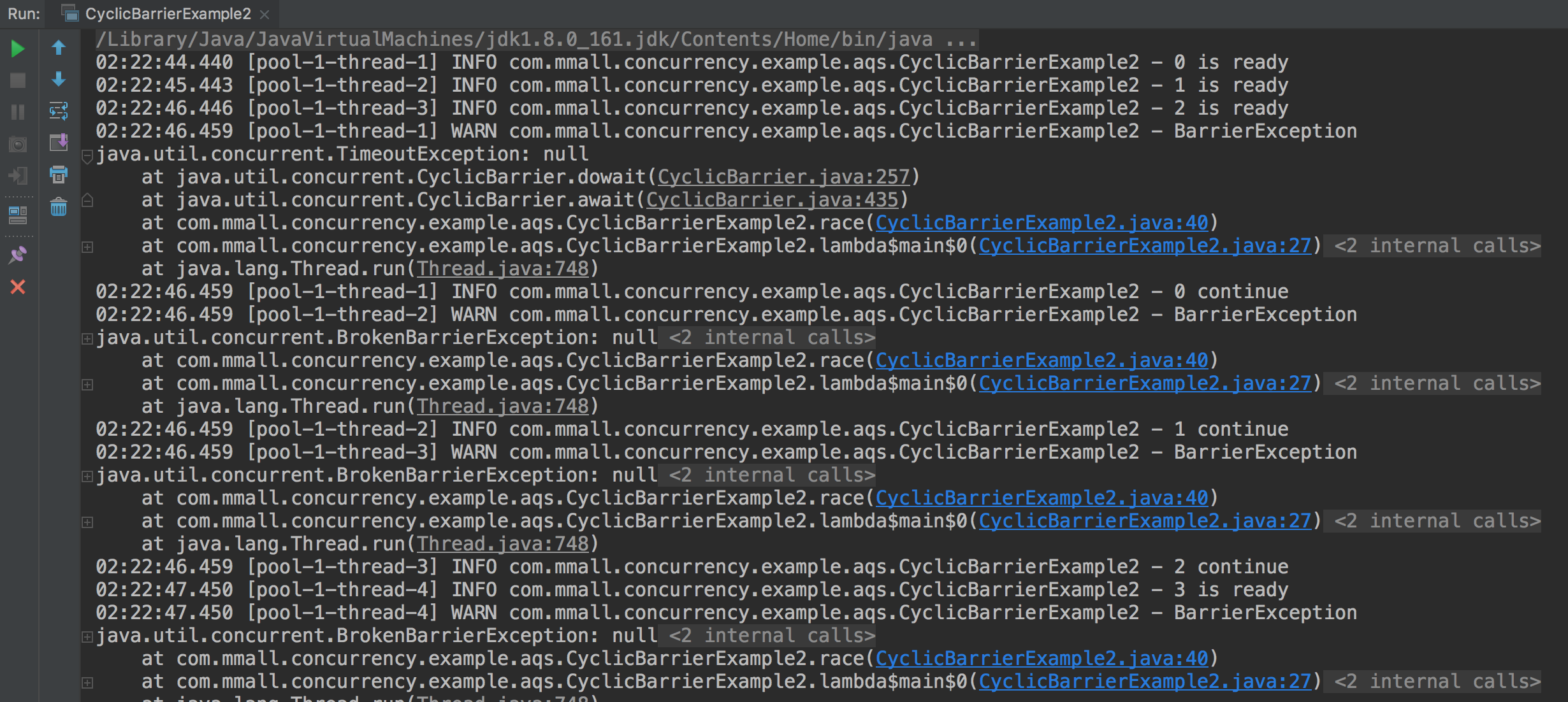
package com.mmall.concurrency.example.aqs;
import lombok.extern.slf4j.Slf4j;
import java.util.concurrent.ExecutorService;
import java.util.concurrent.Executors;
import java.util.concurrent.Semaphore;
/**
* @author JavaEdge
*/
@Slf4j
public class SemaphoreExample3 {
private final static int threadCount = 20;
public static void main(String[] args) throws Exception {
ExecutorService exec = Executors.newCachedThreadPool();
final Semaphore semaphore = new Semaphore(3);
for (int i = 0; i < threadCount; i++) {
final int threadNum = i;
exec.execute(() -> {
try {
// 尝试获取一个许可
if (semaphore.tryAcquire()) {
test(threadNum);
// 释放一个许可
semaphore.release();
}
} catch (Exception e) {
log.error("exception", e);
}
});
}
exec.shutdown();
}
private static void test(int threadNum) throws Exception {
log.info("{}", threadNum);
Thread.sleep(1000);
}
}
#9 线程池
##9.1 newCachedThreadPool
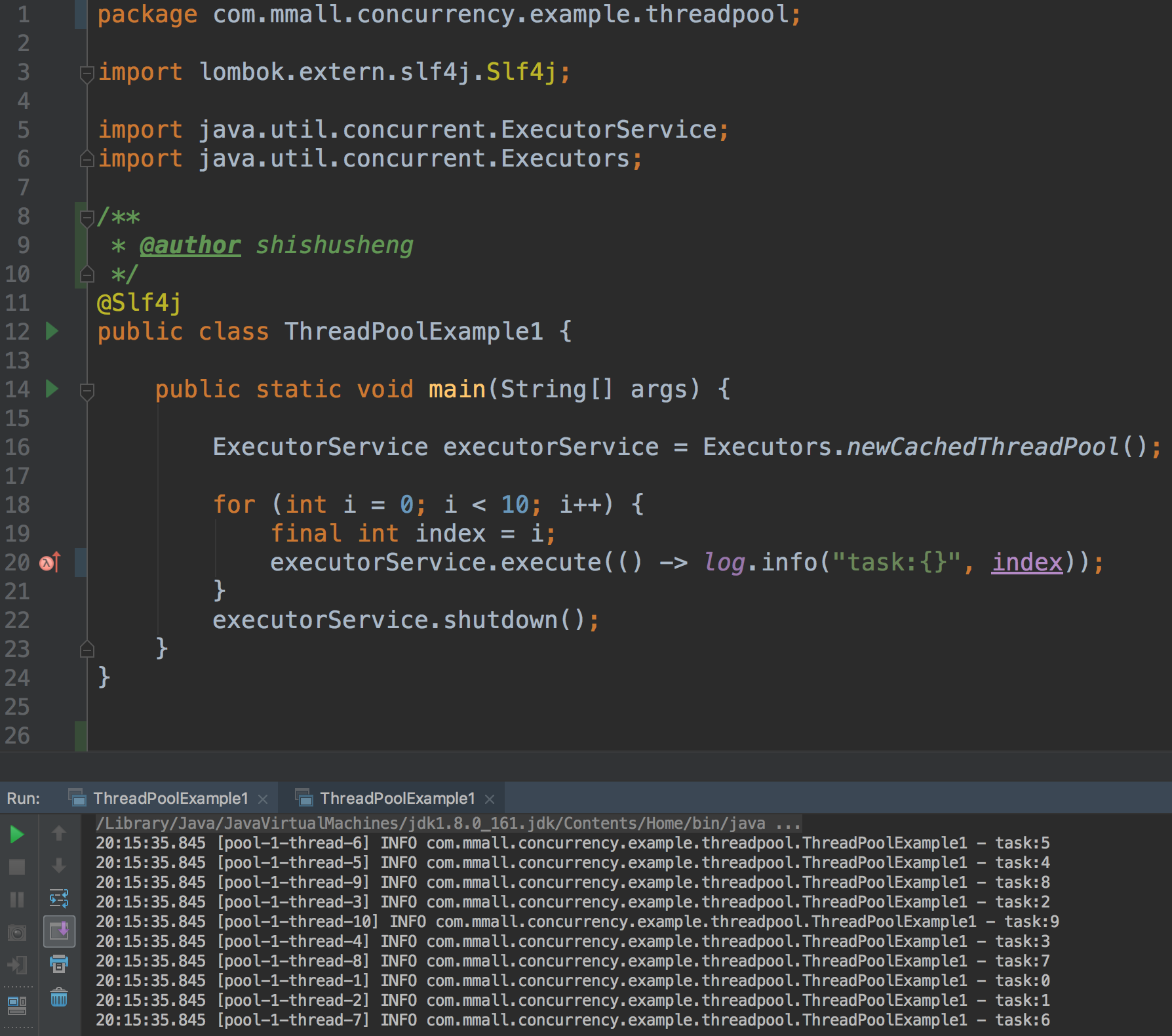
##9.2 newFixedThreadPool
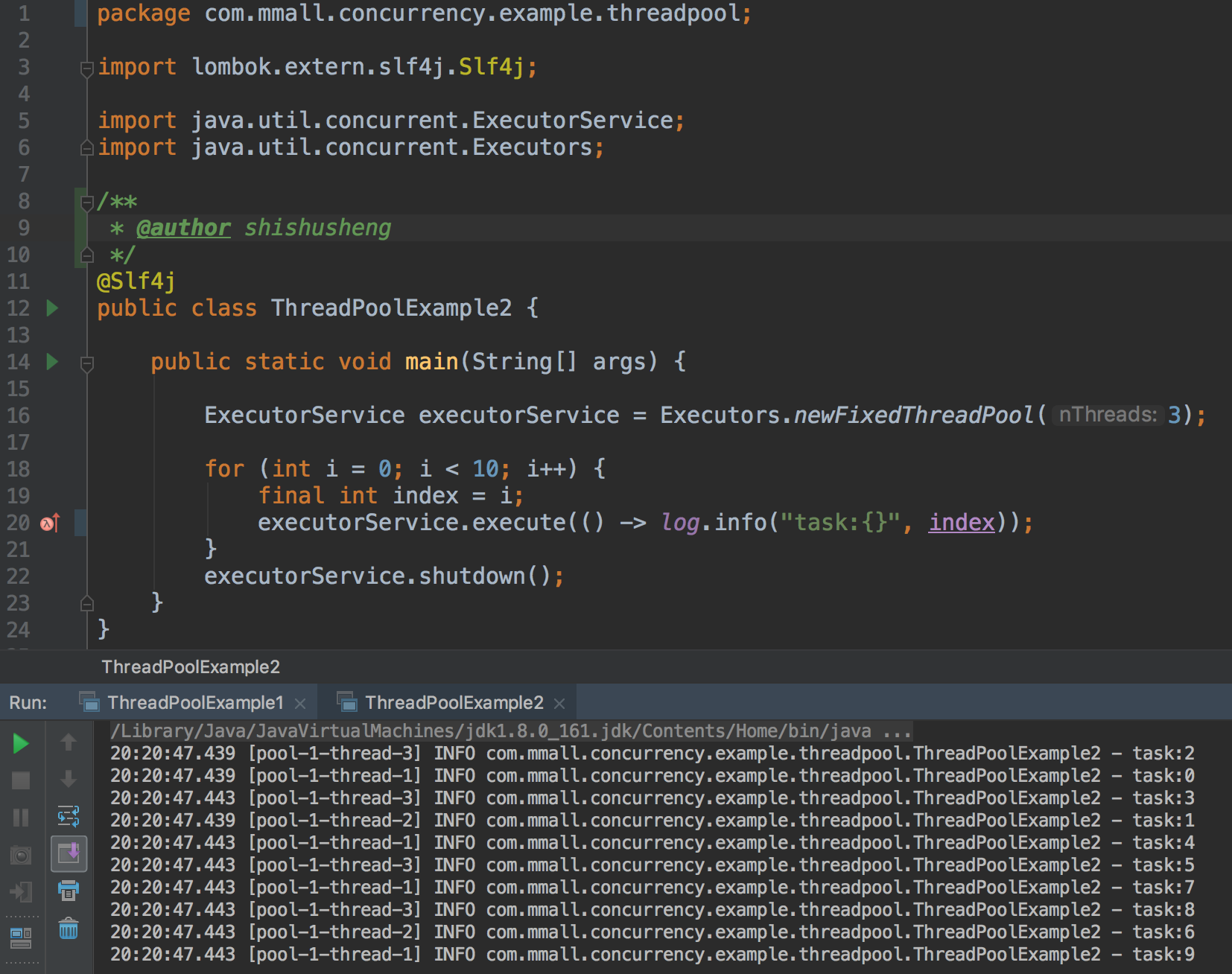
##9.3 newSingleThreadExecutor
看出是顺序执行的
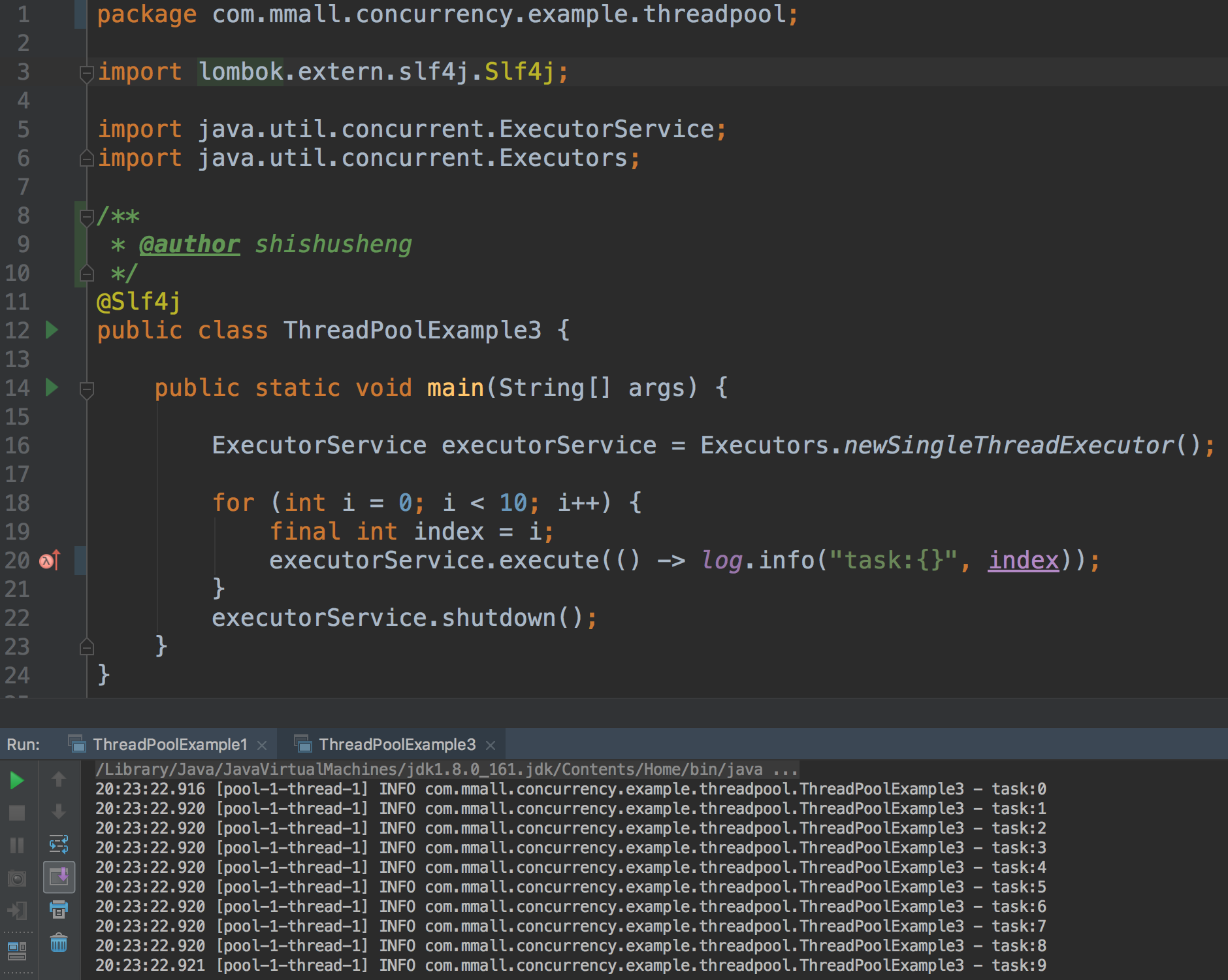
9.4 newScheduledThreadPool
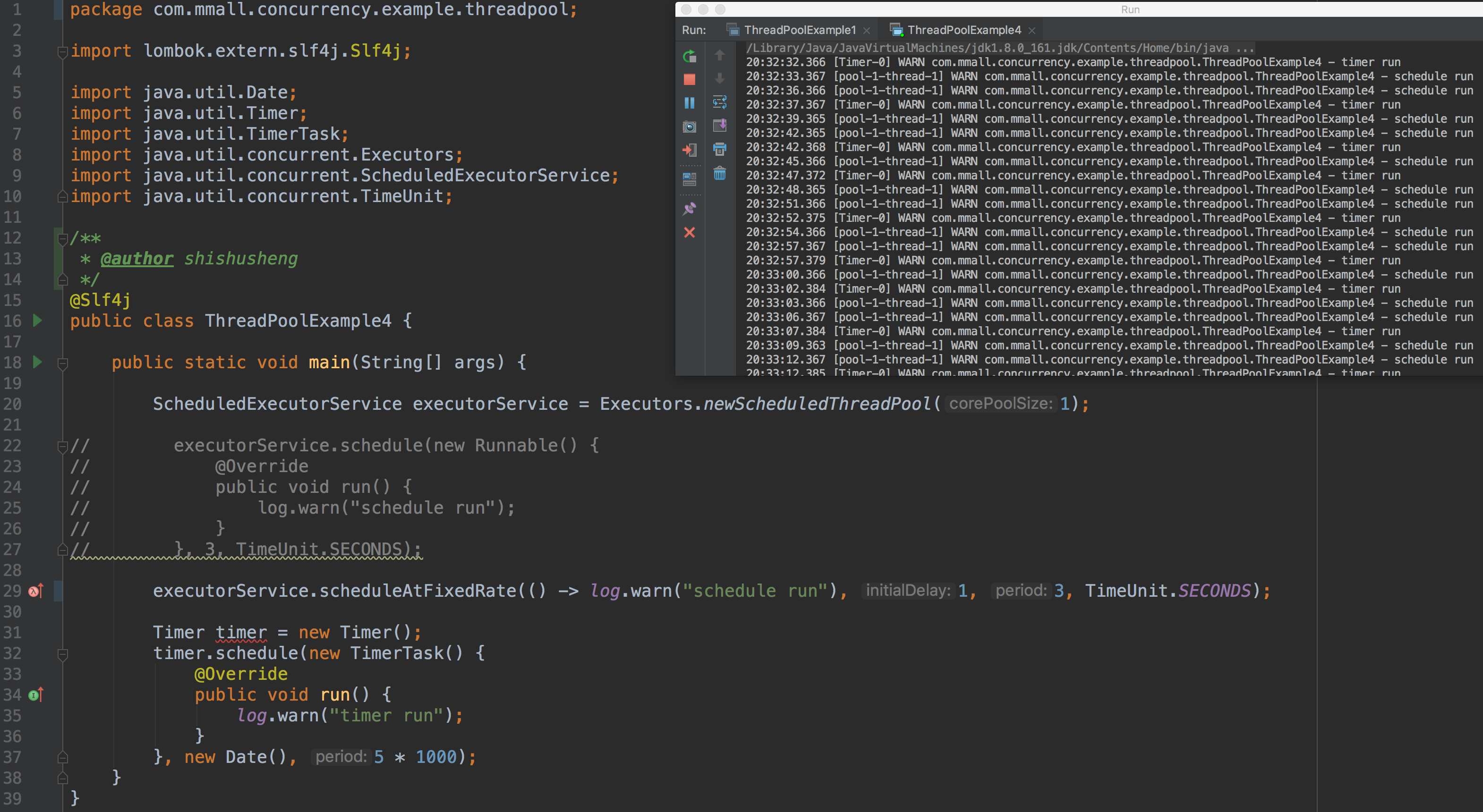
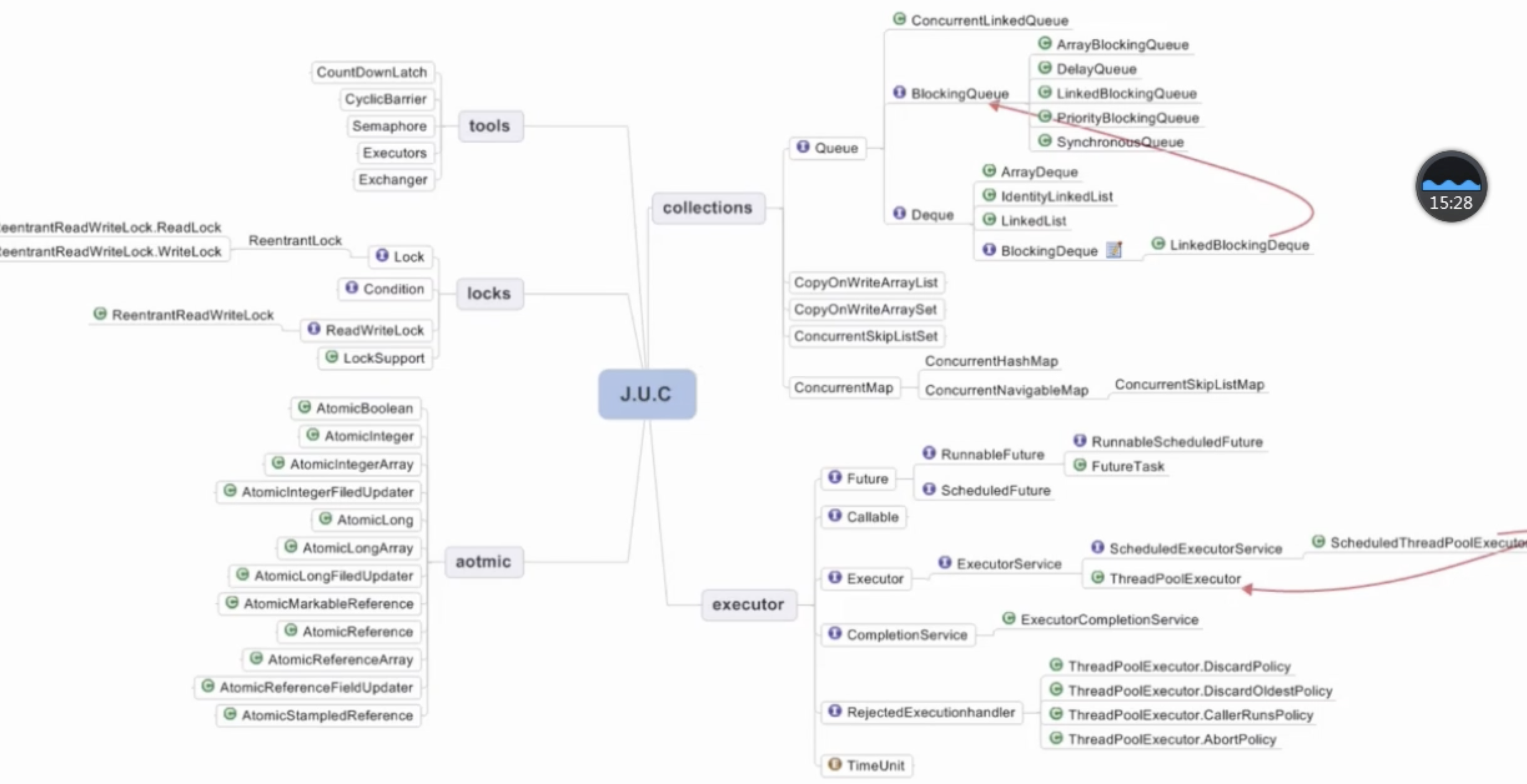
10 死锁
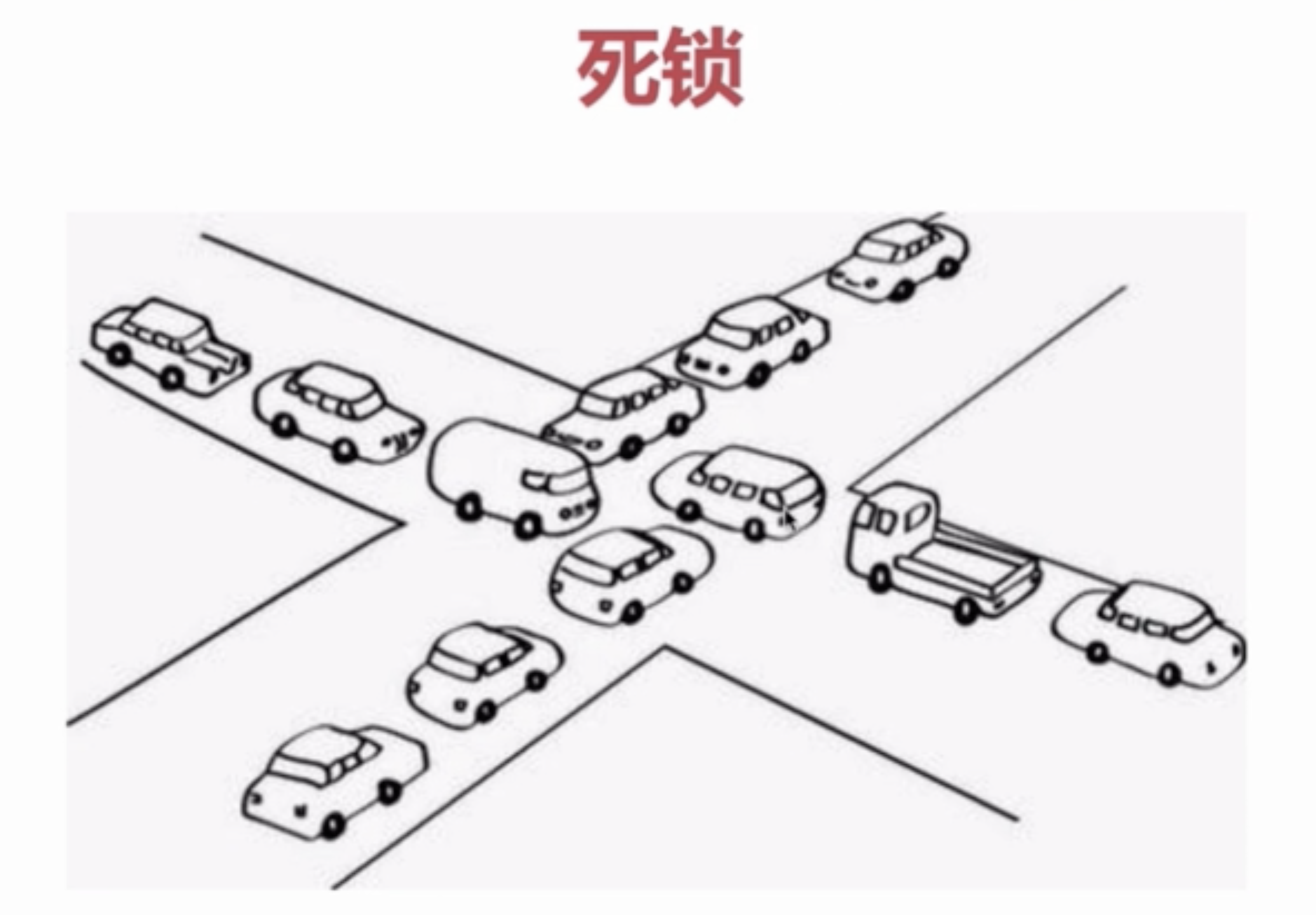

11 高并发之扩容思路
11.1 扩容
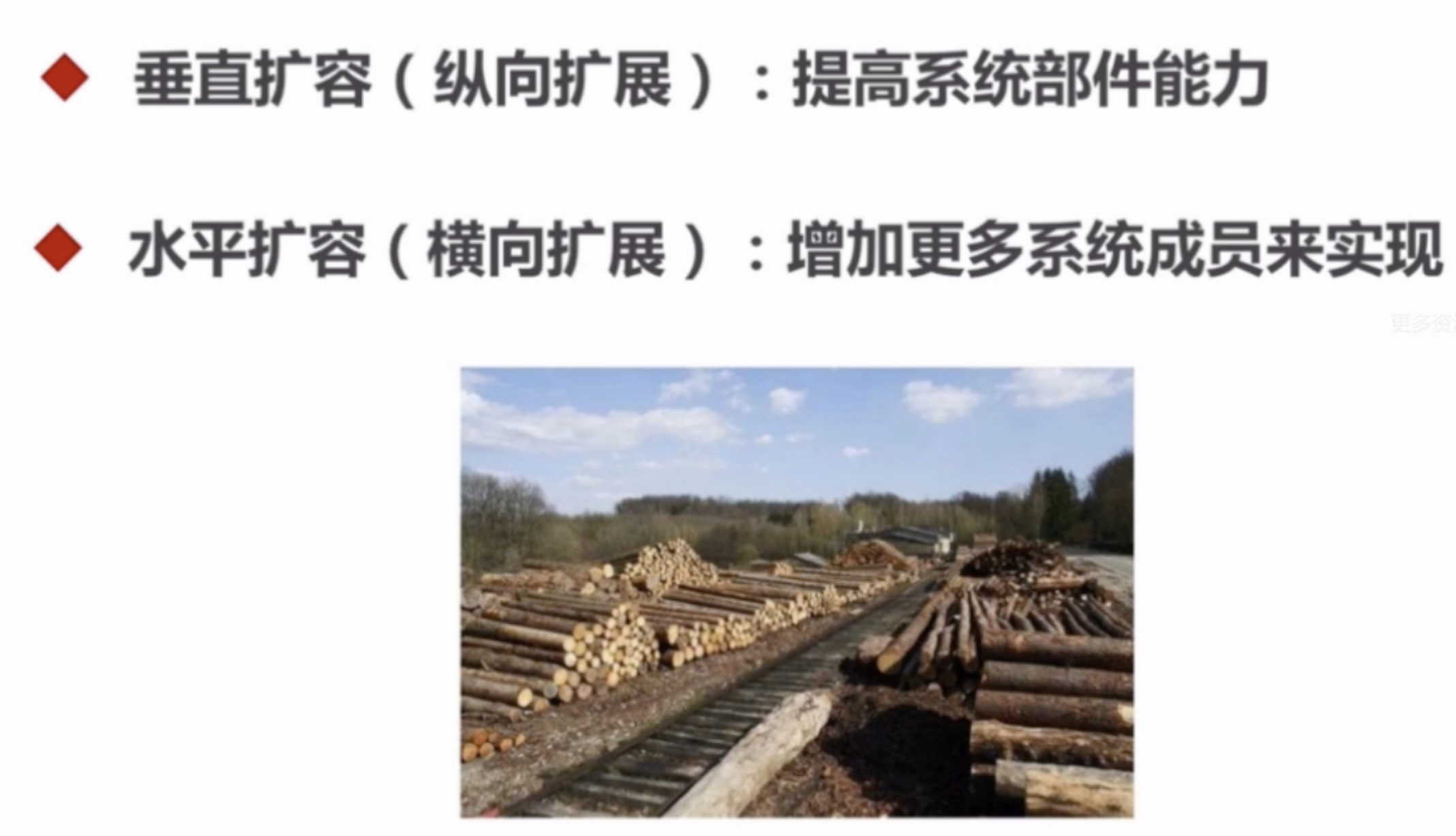
11.1 扩容 - 数据库

12 高并发之缓存思路
12.1 缓存
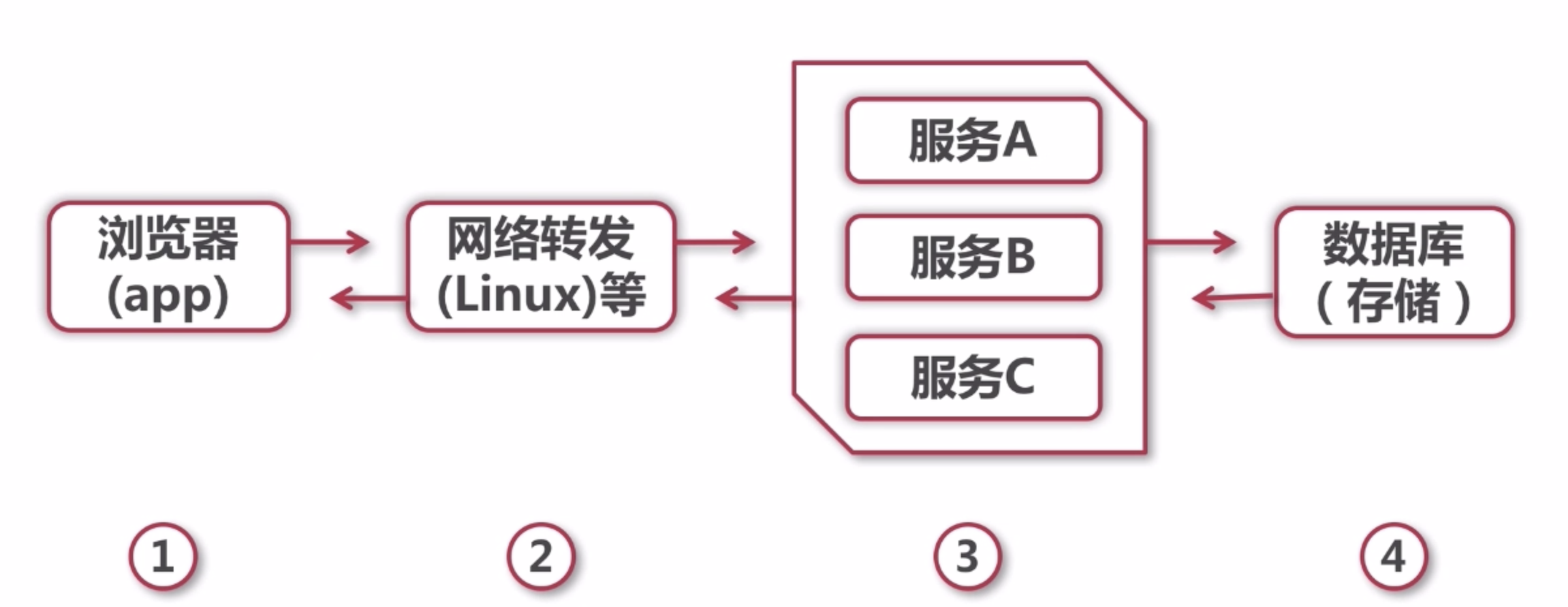
1 缓存特征

2 缓存命中率影响因素

3 缓存分类和应用场景

12.2 高并发之缓存-特征、场景及组件介绍
1 Guava Cache
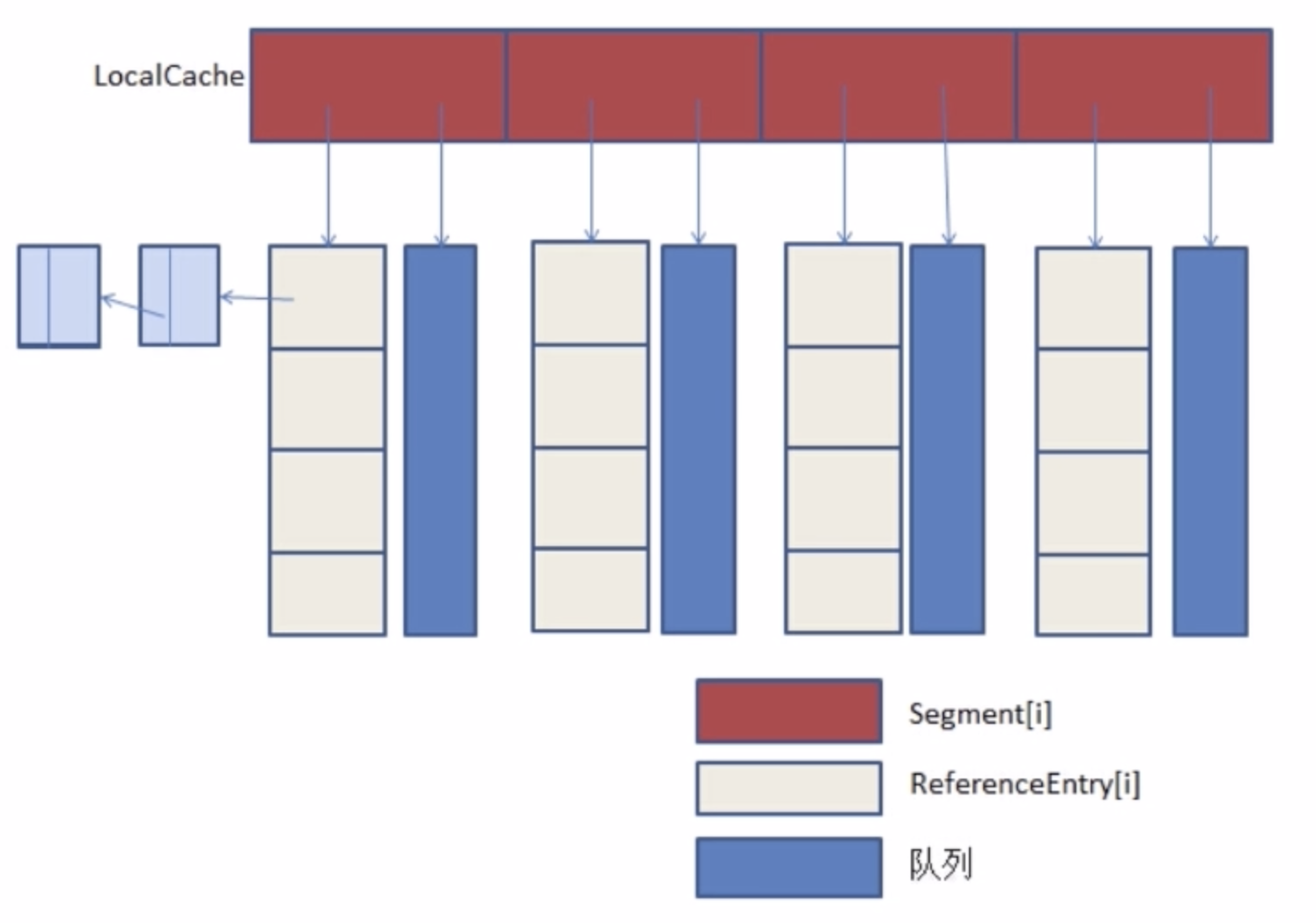
2 缓存 - Memchche
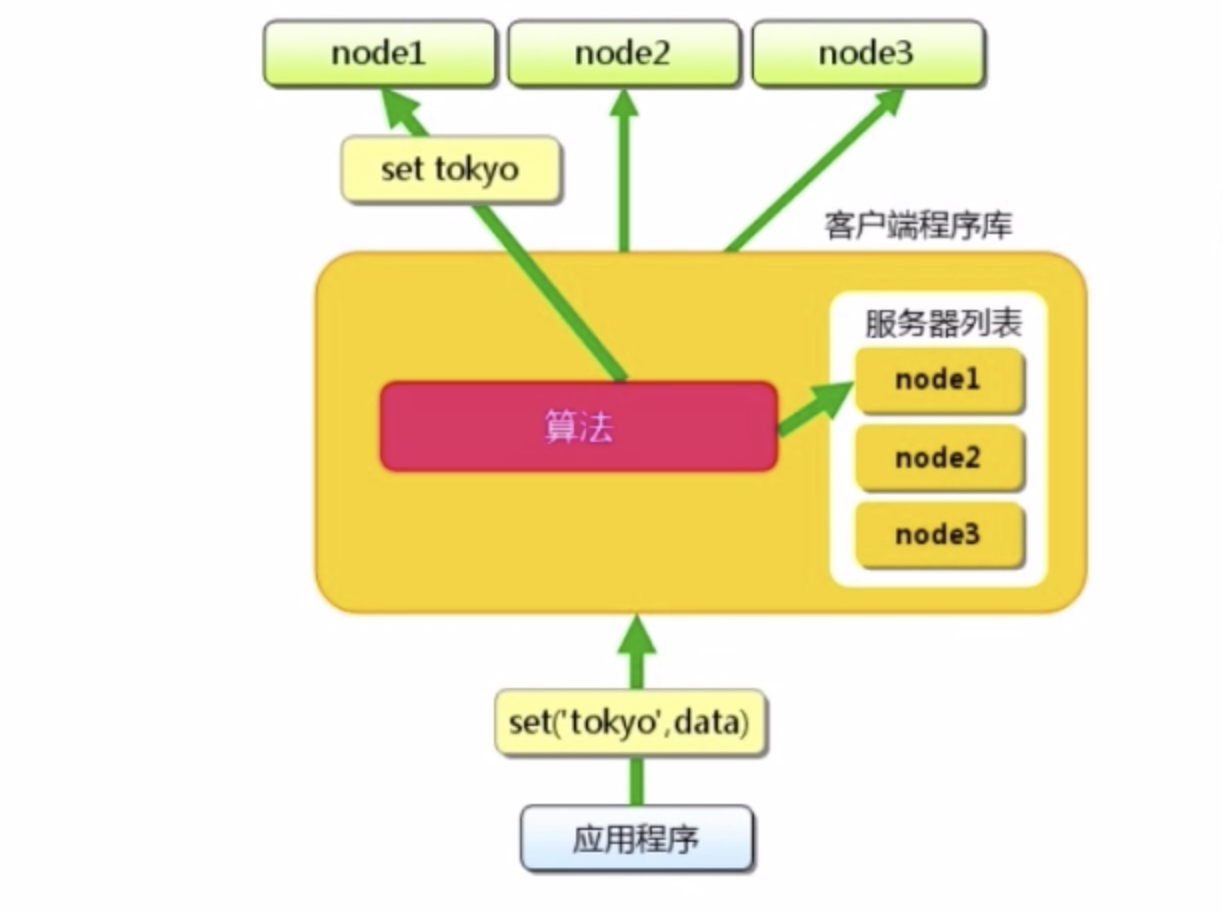

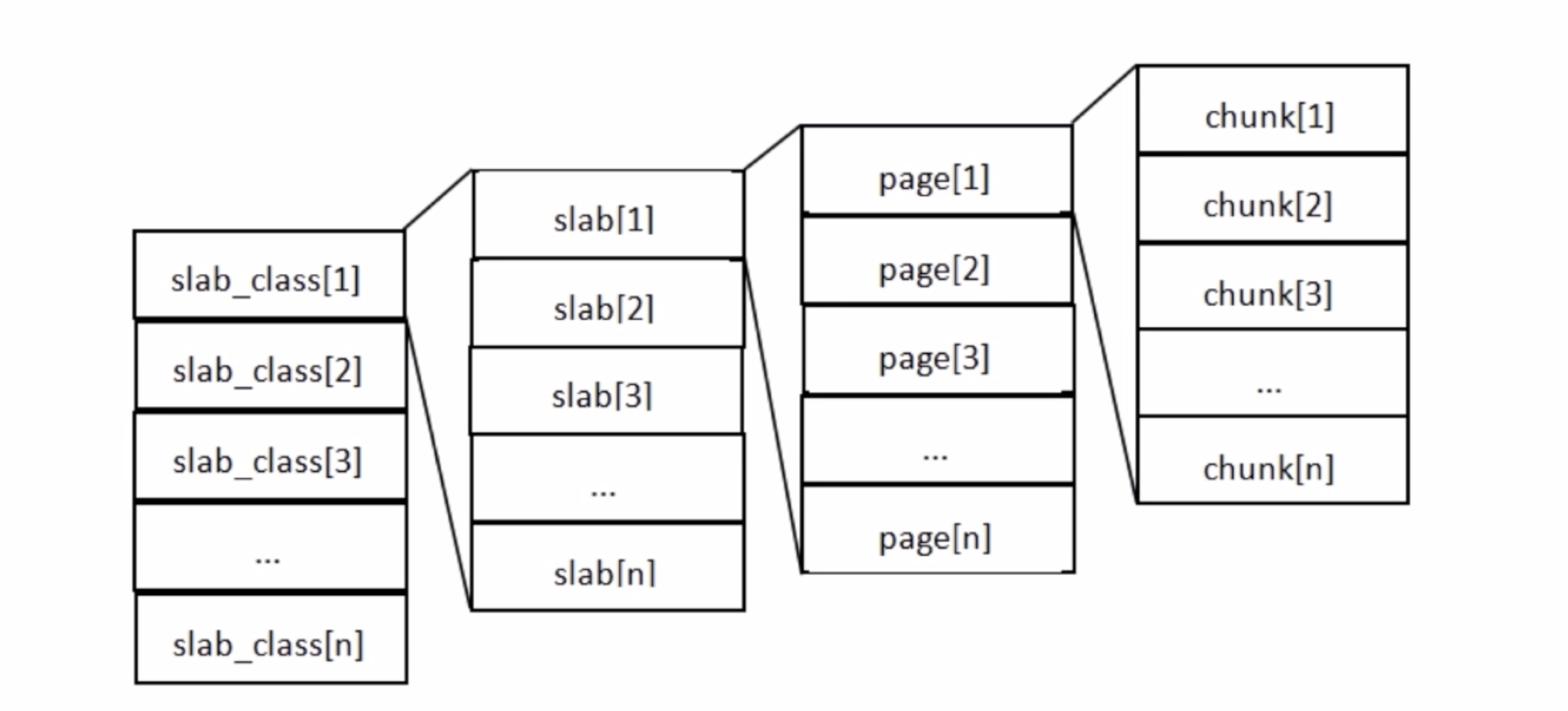
3 缓存 - Redis
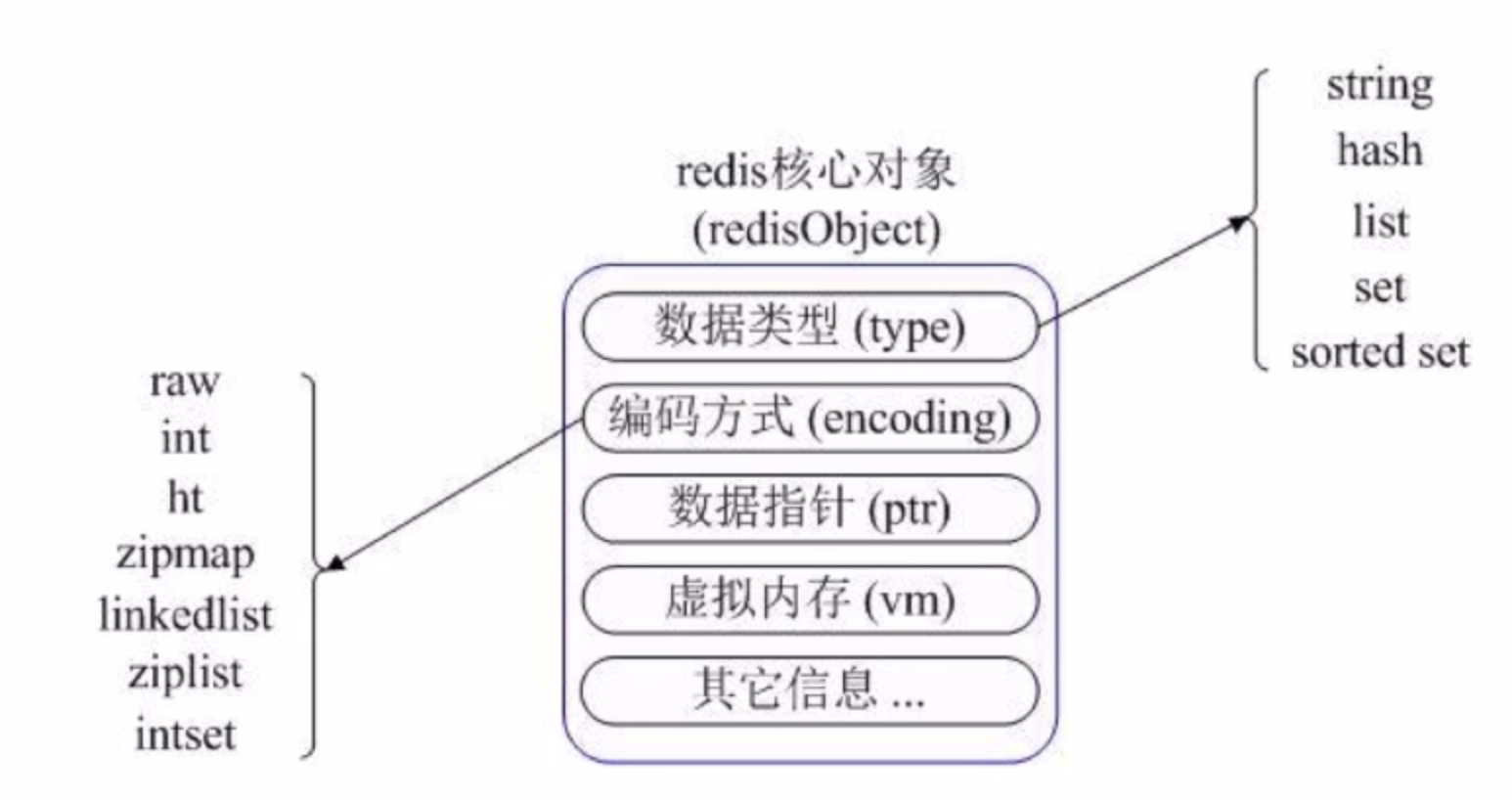
12.3 redis的使用
- 配置类
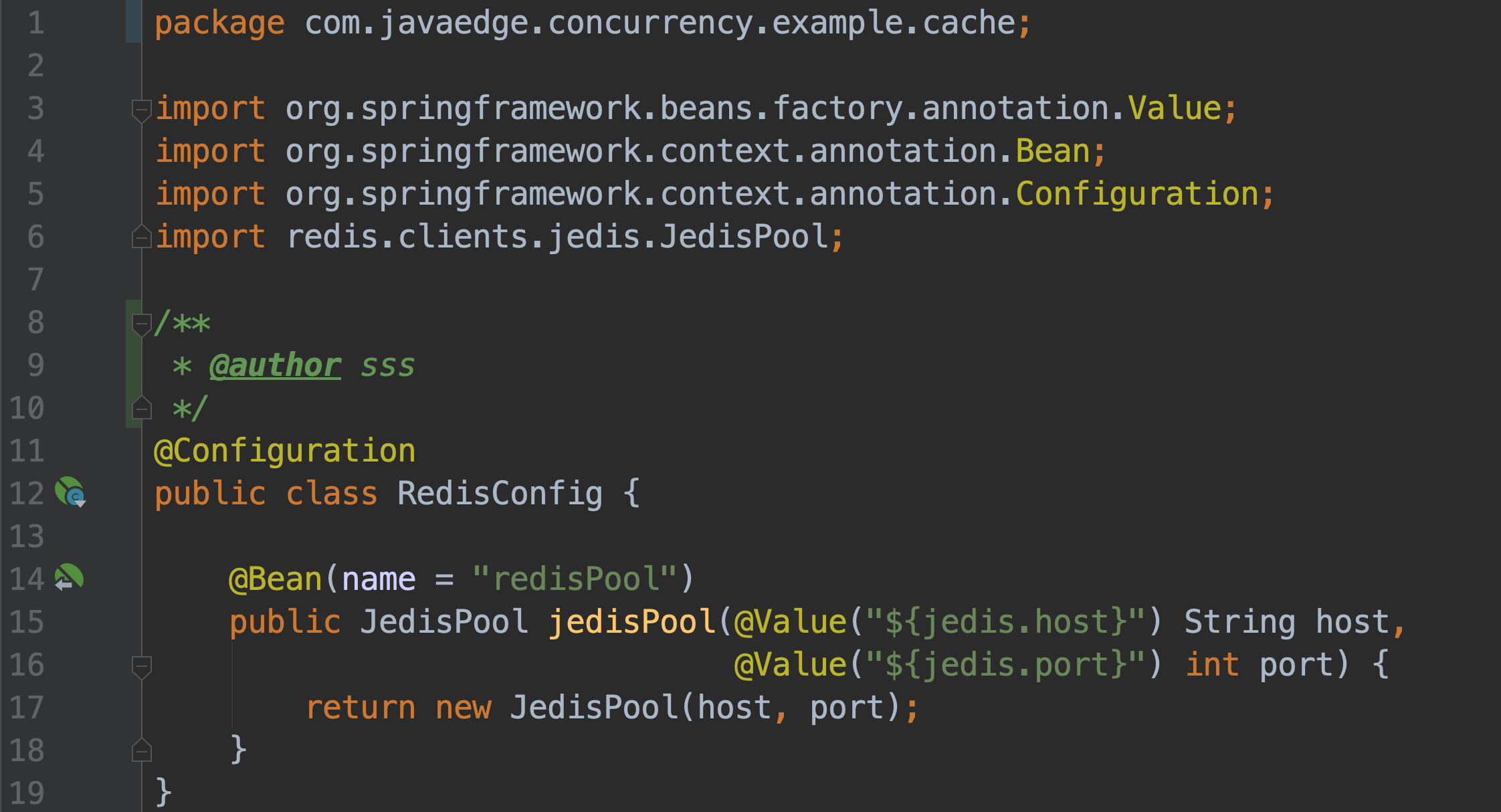

- 服务类
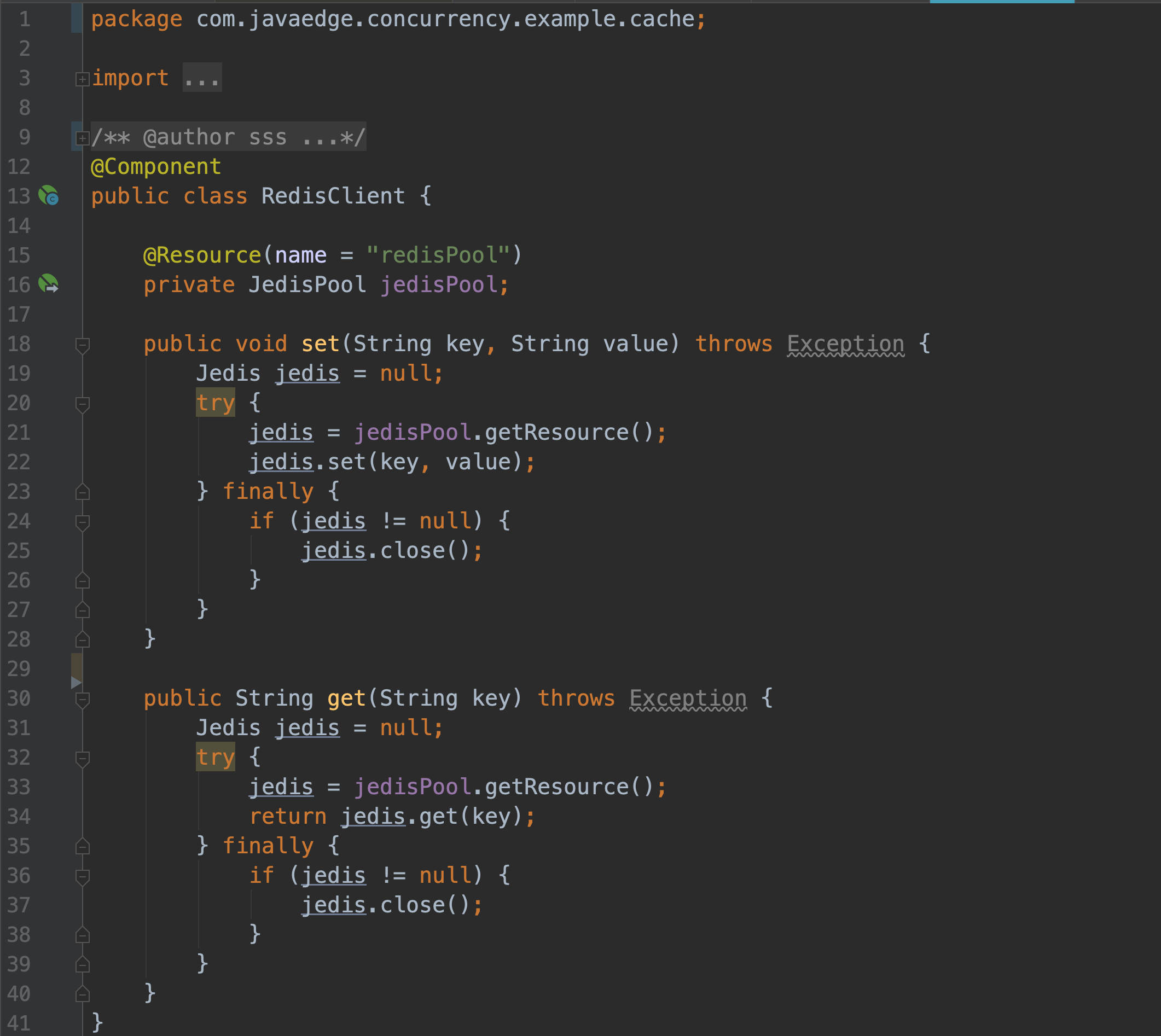
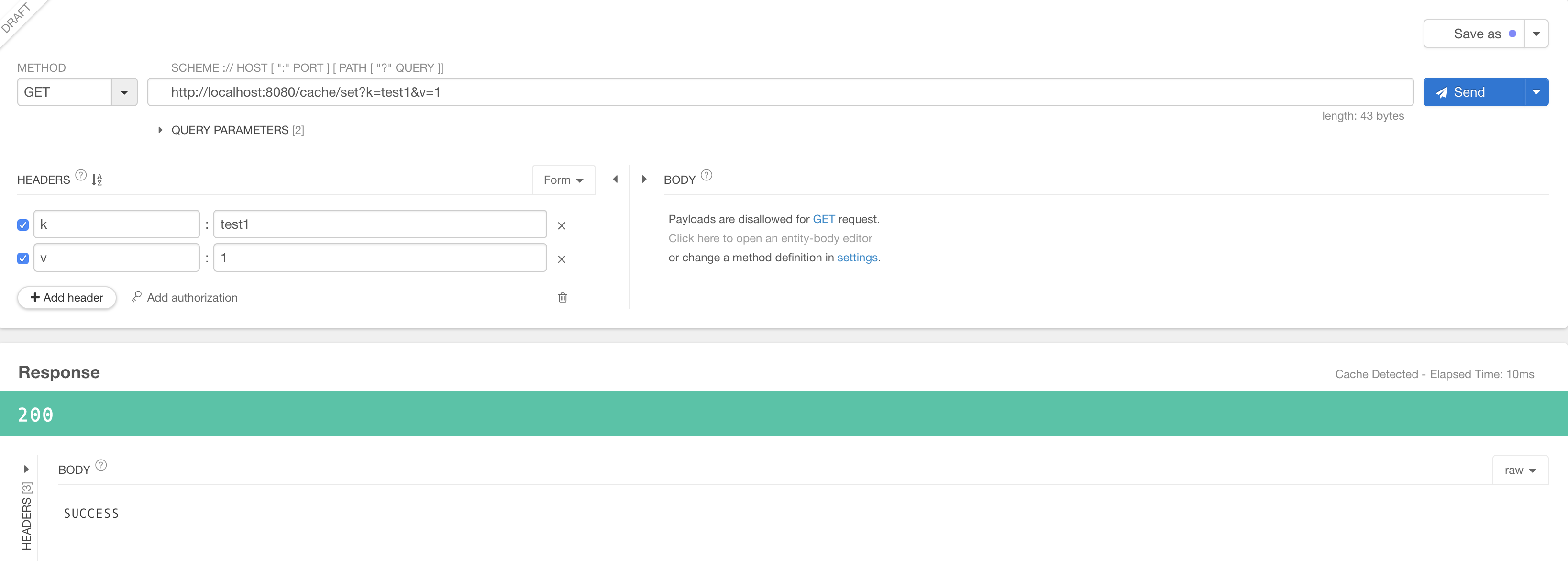
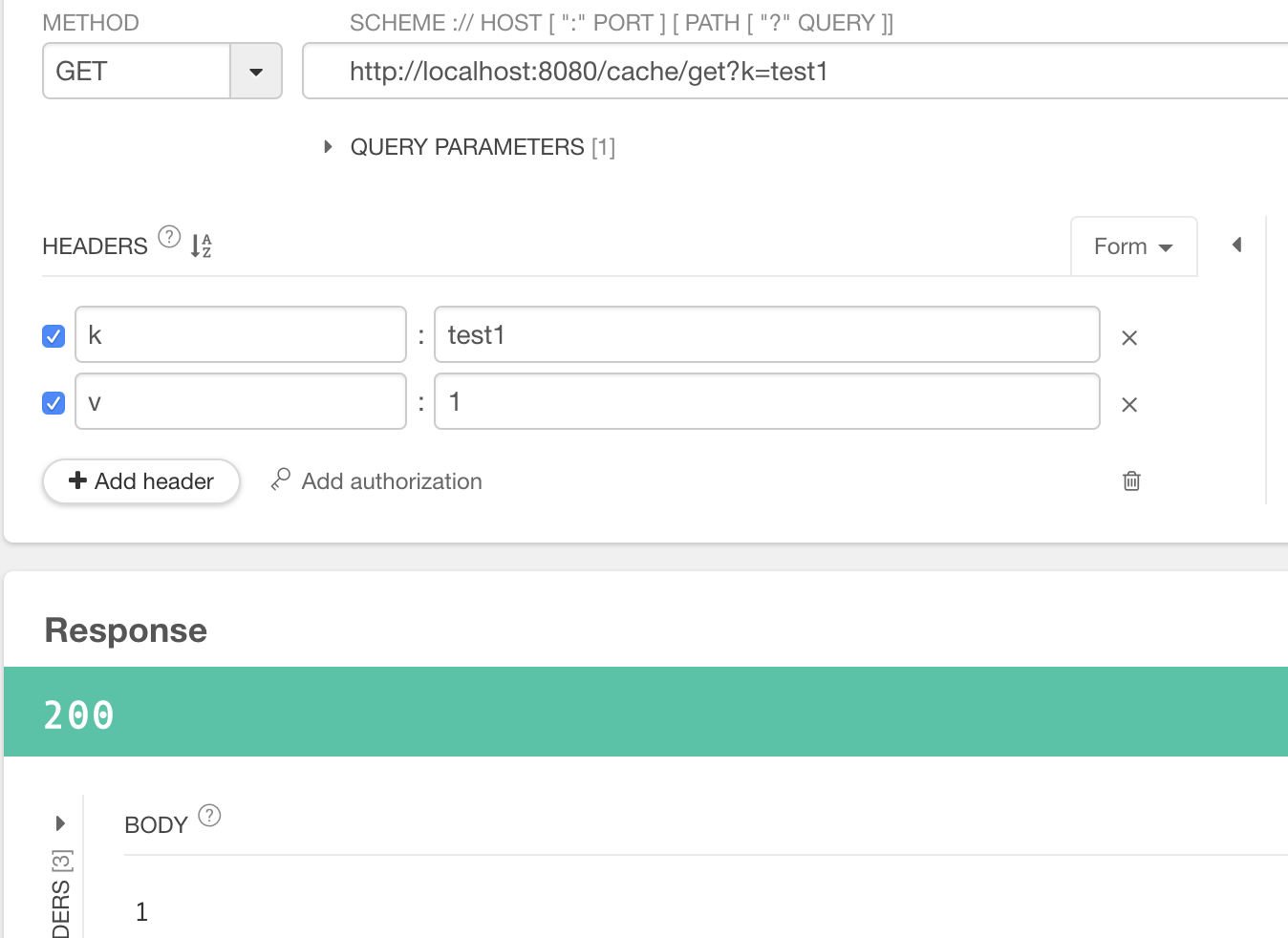
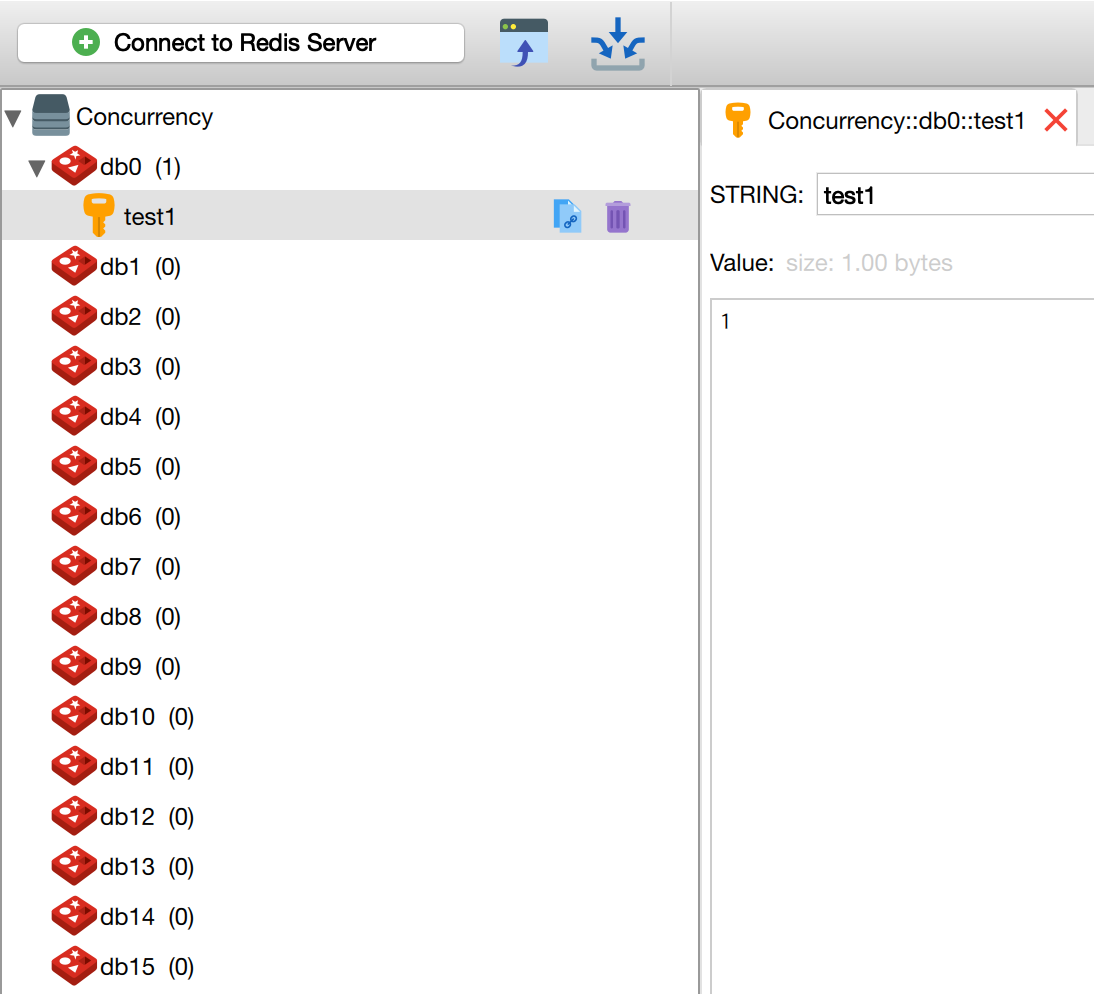
12.4 高并发场景问题及实战
缓存一致性
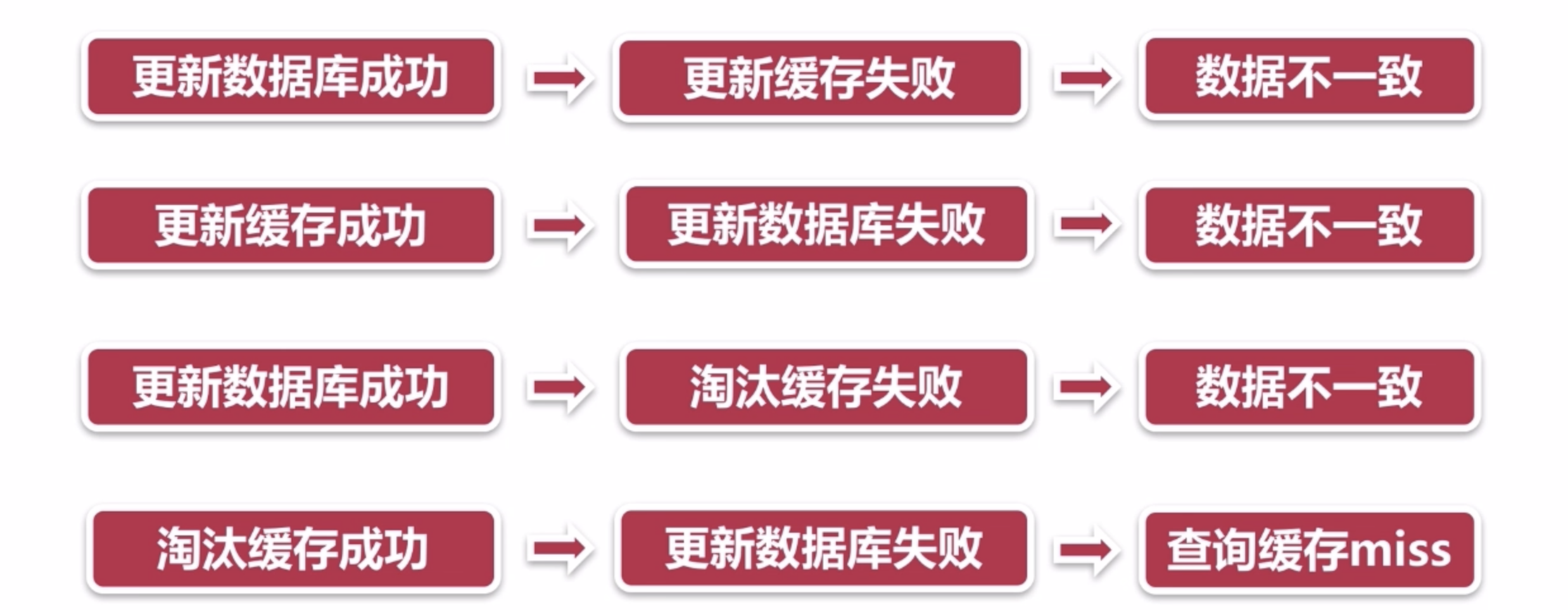
13 高并发之消息队列思路
13.1 业务案例

将发短信封装成一条消息放进消息队列中,若发生短信过多,队列已满,需要控制发送的频率.
通过将事件封装成消息放入队列,实现了业务解耦,异步设计,确保了短信服务只要正常后,一定会将短信成功发到用户.
13.2 消息队列的特性

-
为何需要消息队列呢

-
优点


队列
kafka
